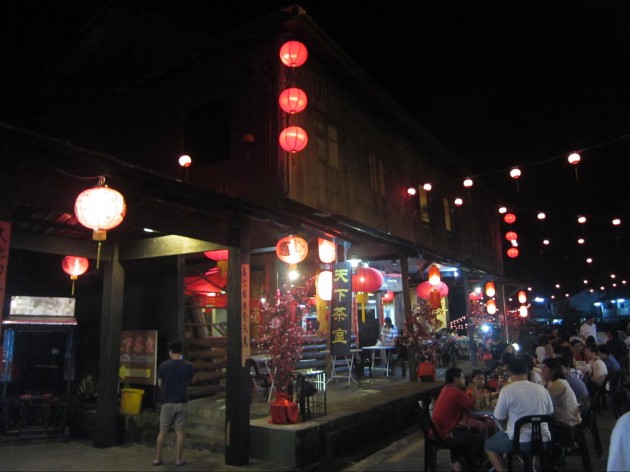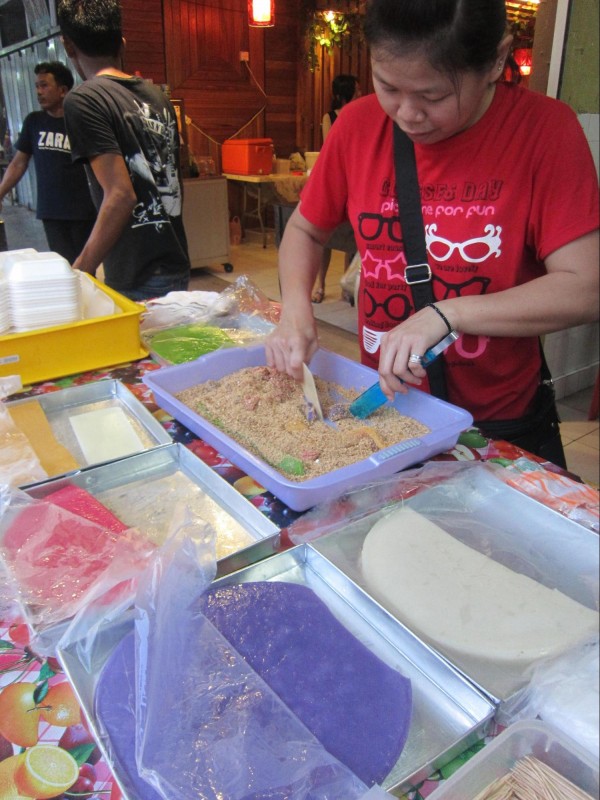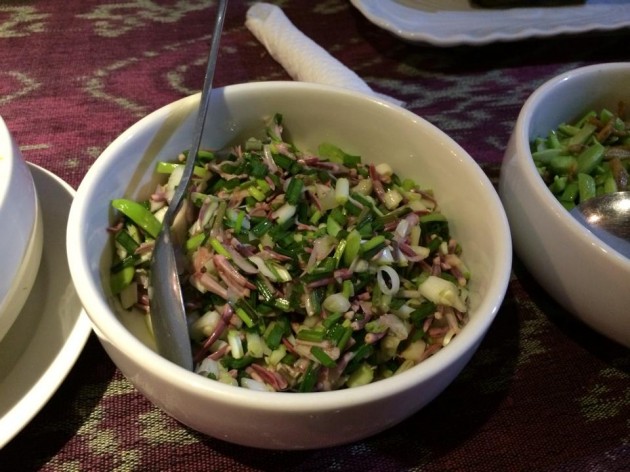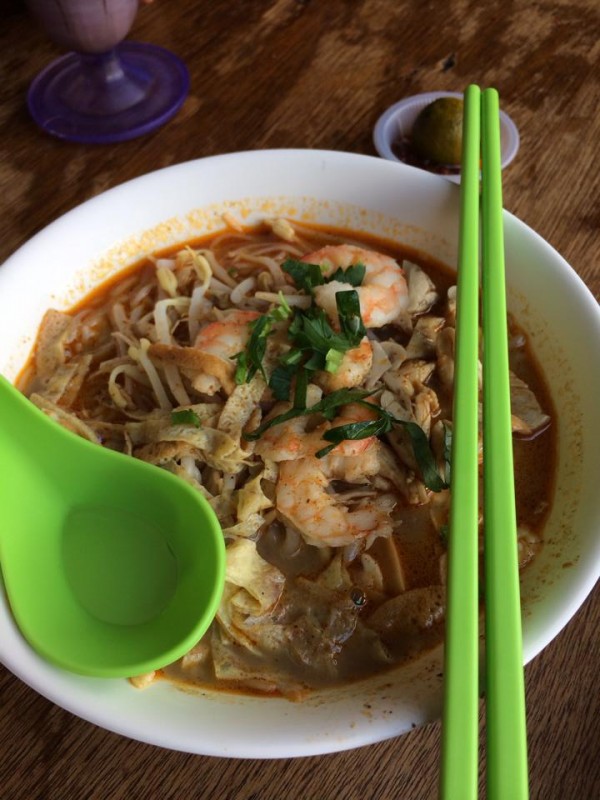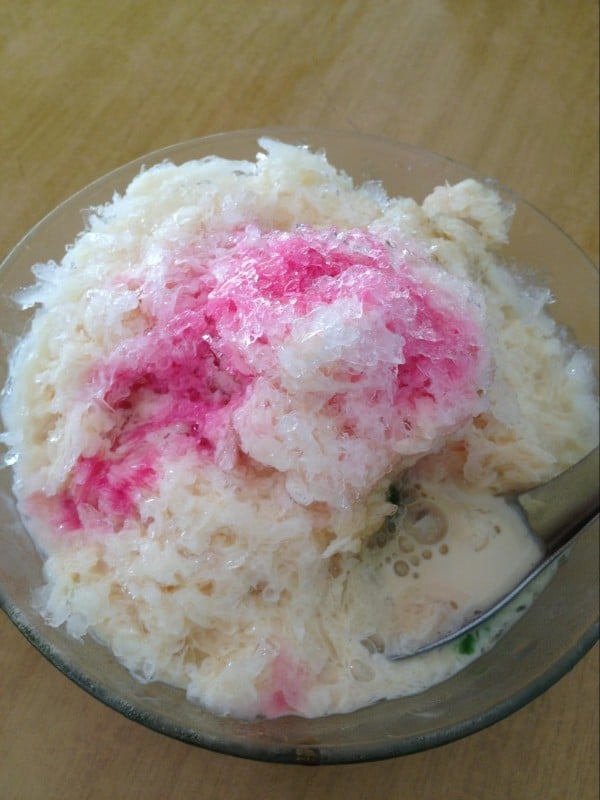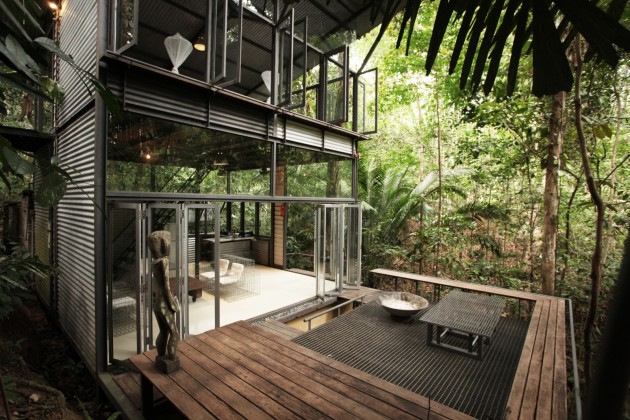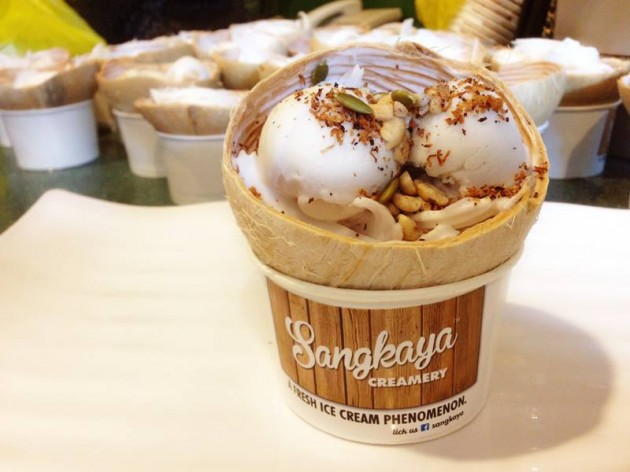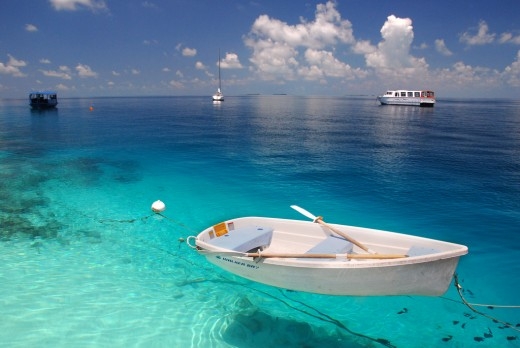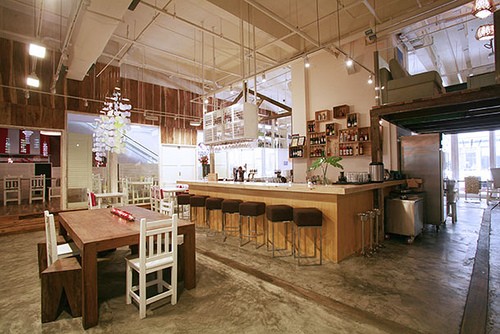Things to Do in Sarawak
“Do you guys have internet?”
“Are the roads like.. straight over there?”
“You don’t really live in treehouses…right?”
These are the sort of questions I get whenever I visit another state and introduce myself as a Sarawakian. Don’t get me wrong! A lot of these questions make me laugh because they are from teasing friends but I’ve also gotten a number of serious queries that are exactly the same. I don’t blame anyone for asking because if you’ve never been to Sarawak, how would you know?
And that’s why I’ve come up with this list.
Everyone who’s never been to this side of Malaysia deserves to experience all the good fun, sheer beauty and glorious food that Sarawak has to offer. It’s time to start making plans for your next holiday with this list of 50 things to do in Sarawak.
1. Go River Kayaking in the Rainforest
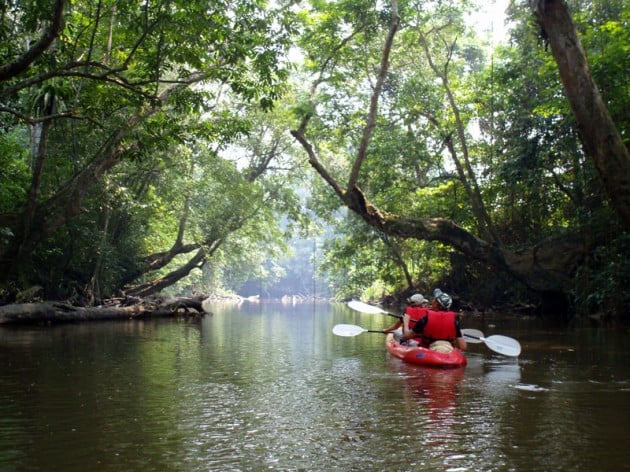 Photo Credit: Kuching Kayak
Photo Credit: Kuching Kayak
Honestly, there isn’t anything quite as serene as river kayaking. Some may think that river kayaking is lot of hard work but really, it’s entirely up to you how hard or how fast you want to go! Heck, I even once kayaked with a group of tourists who decided to stop paddling and instead, kick back and relax with a couple of drinks as the kayak was gently propelled downstream by the currents (of course there were stretches of river where they couldn’t do that but you get the idea!). Kuching has several well known kayak operators who would gladly take you and yours on a unique adventure that makes you forget the hustle and bustle of city life. Plus, not only will these operators keep you safe, they’ll also tell you interesting snippets about your surroundings and even make sure to snap photos for your instagram as you go along! You might even get to stop by a kampong or two along the river depending on which company you decide to go with.
Traveller tip: A quick search on google will help you find several kayaking companies. Personally, I’ve gone with Borneo Trek and Kayak Adventure twice now and have felt well taken care of. However, I would suggest that you call up a few places or even compare notes on TripAdvisor in order to find the right company that you feel comfortable and safe with!
2. Explore Mulu National Park
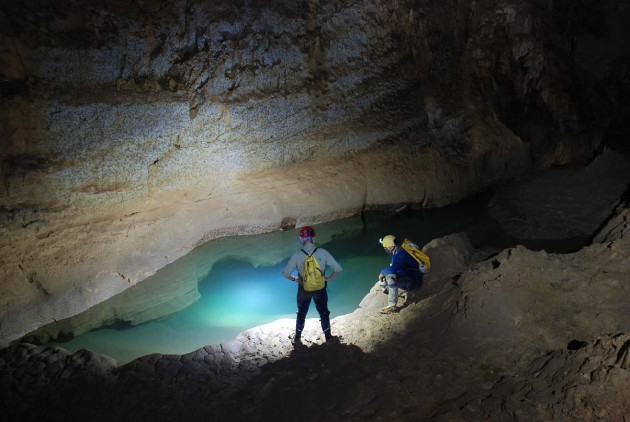 Photo Credit: Mulu Caves
Photo Credit: Mulu Caves
Being classified as a world heritage site is like winning the Oscars of Mother Nature and Malaysia has been fortunate enough to have attained several of these titles. Listed as a world heritage site by UNESCO in 2000, Mulu National Park is one of the most gorgeous places you can visit in Malaysia, if not the world.
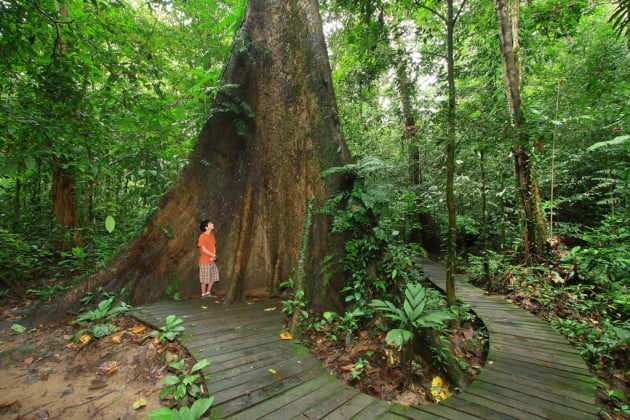 Photo Credit: Alan Cressler
Photo Credit: Alan Cressler
The caves here are genuinely jaw-dropping but it wasn’t just for its beauty that Mulu was recognised. The park is also a significant natural habitat, full of wildlife not easily found elsewhere. If you think that Mulu National Park is your ‘typical’ trek and snap, it isn’t! There’s a lot to do here. From adventure caving to kayaking to visiting native settlements and waterfalls, there’s a lot of Mulu to take in. And if you do decide to make the trip out here, you have to catch the bats leaving at sunrise. It’s a sight to behold.
Getting here: MAS runs flights to Mulu from Kuching, Miri and Kota Kinabalu several times a week.
Traveller Tip: Make bookings in advance as there are limited beds within Mulu National Park and the place is usually booked full during peak season (June-September). There is of course, the Mulu resort, but that would be the pricier option. Consider signing up to a tour group or package to make your stay more educational and economical!
3. Party In A Jungle Rainforest
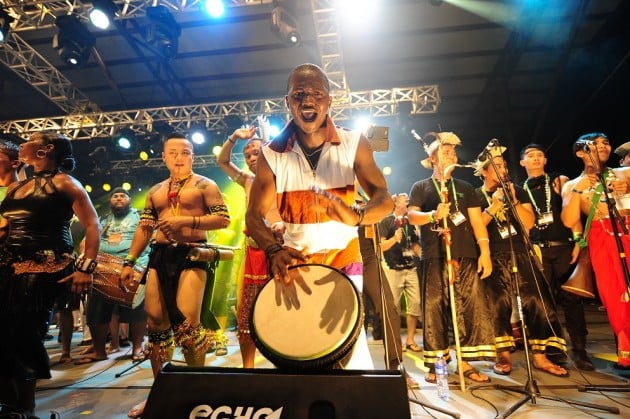 Photo Credit: RWMF
Photo Credit: RWMF
Held yearly at the Sarawak Cultural Village, the Rainforest World Music Festival brings together world-renowned indigenous musicians for a festival unlike any other. The festivities last for three days, with music, dance and craft workshops during the day and an eclectic (non-mainstream) line-up of music performers at night.
If workshops aren’t your thing, there’s plenty to do in the surrounding area of the Damai peninsular. There are several beach fronts for you to recover from partying away the night before or, if you’re up for something vigorous, you could even go sea-kayaking at Camp Permai or take a hike up Mt. Santubong.
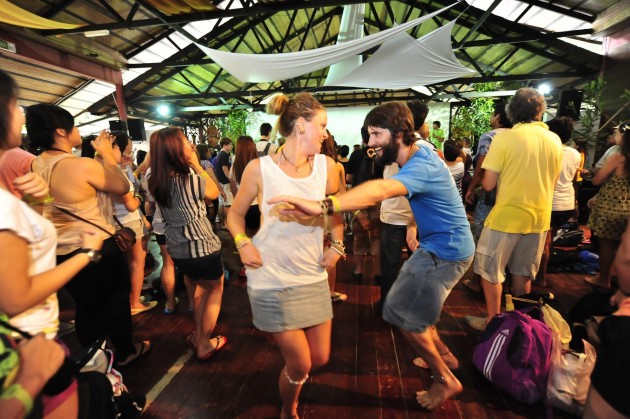 Photo Credit: RWMF
Photo Credit: RWMF
Just imagine the combination: beautiful music, a decent amount of alcohol and an electric atmosphere like no other. All set in the heart of the jungle. What party could be more exotic than that?
Getting here: Both AirAsia and MAS run daily flights from Singapore/KL to Kuching and Sarawak Cultural Village is about 30-40 minutes away from the city centre. Do check out the official website for more information.
Traveller tip: Cheap accommodation located close to the village is often booked out by the time June comes around. However, there’s always the option of staying in the city centre as shuttle transport is usually provided by the larger hotels.
4. Discover Old-School Siniawan Night Market
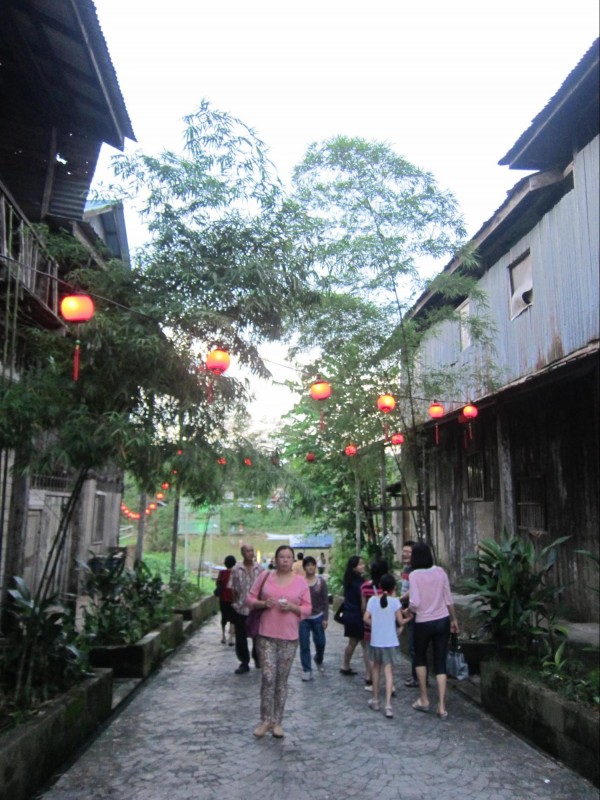 Located a half-hour’s drive away from Kuching’s city centre, the sleepy little town of Siniawan comes alive every weekend with a bustling night-market lively enough to rival that of any major city. Once badly devastated by floods, the old shophouse here were beautifully restored to their former glory, keeping in with the old-school feel of the town.
Located a half-hour’s drive away from Kuching’s city centre, the sleepy little town of Siniawan comes alive every weekend with a bustling night-market lively enough to rival that of any major city. Once badly devastated by floods, the old shophouse here were beautifully restored to their former glory, keeping in with the old-school feel of the town.
The drive to Siniawan can be a little eerie after sundown as the roads are not well lit so I can forgive you for thinking that it’s all a little like the beginning of a bad horror movie. But, once you turn off the main road into town, it’s an entirely different scene! Bright red lanterns are strung across the street that’s lined with hawkers. The air is often smoky from the cooking but everything smells delicious!
The place is often crowded with people eating at mismatched tables so you’d have to navigate your way around to find an empty spot. However, there are also a few restaurants further down the street if you’d like to have a ‘round-table’ dinner. Enjoy the cheerful atmosphere and muster enough courage to get up on the karaoke stage, it’s free!
Getting here: Turn off into Jalan Bau from Jalan Penrissen (that big intersection near Lalapan restaurant) and keep going straight before turning right into Jalan Siniawan. The sign may be a little difficult to make out so keeping Google Maps open would be handy.
Traveller tip: The market goes into full swing around 6 or 7 and winds down a little after 9 so come before then. Make sure to order some multi-coloured muachi (glutinous rice flour kuih covered in peanut-y goodness). That stuff’s goo-od
5. The Month Long Kuching Food Festival
9 times out of 10 when you ask a local Kuchingite what there is to do in town, they’ll reply you with a blank stare and say.. ‘Eat la!’ as if there couldn’t be a more obvious answer. So in response to their love of food, the city council organizes an annual MONTH-LONG food festival.
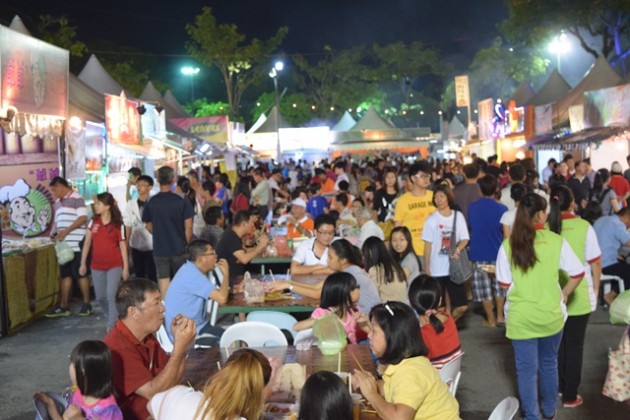 Photo Credit: Danielle Sendou Ringgit
Photo Credit: Danielle Sendou Ringgit
Every year the food festival just seems to get bigger ( there were over 200 food stalls alone last year). Some are run by well-known restaurants and cafes but more often than not, some of the best food to be found at Kuching Fest is cooked up by the stall owners who only sell their dishes during this month-long festival of yumminess. However, not all food is created equal and every festival, there seems to be that one particular stall that’s captured the curiosity of the locals, one year it was durian puffs, another year it was deep-fried milk!
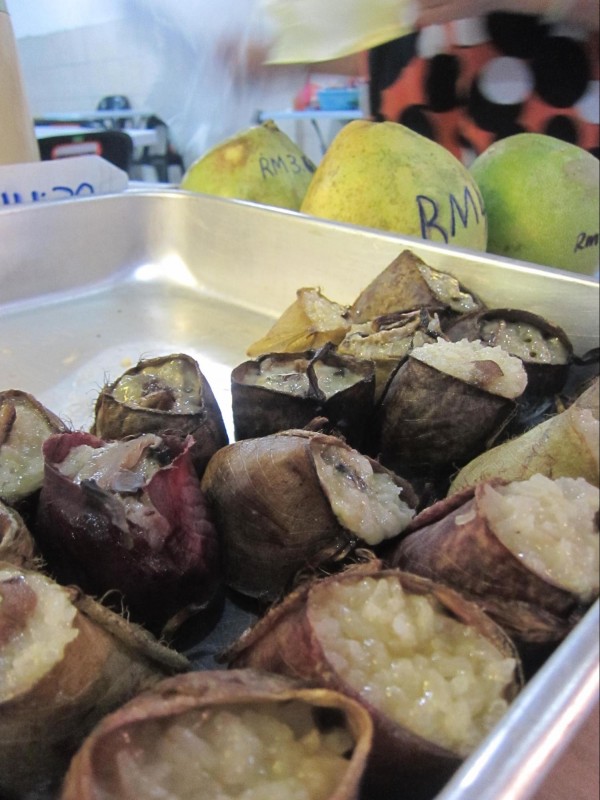 So make sure to drop by if you’re in Kuching during the month of August to catch this year’s latest craze. And if you feel the need to walk off all that food, the festival also plays host to a garden show and variety of performers, definitely something worth checking out!
So make sure to drop by if you’re in Kuching during the month of August to catch this year’s latest craze. And if you feel the need to walk off all that food, the festival also plays host to a garden show and variety of performers, definitely something worth checking out!
Getting here: The festival has always been held at the Compound Dewan Masyarakat and Kuching Park (right next to Chung Hua Primary School No. 3) but do check for updates just in case.
6. Surf The Waves At Pesta Benak
Otherwise known as the Tidal Bore festival, Pesta Benak is held annually in the town of Sri Aman, along the Batang Lupar river. A tidal bore is a natural phenomenon where the incoming tide is funneled up a river, resulting in a visibly large wave that travels against the river current. Tidal bores are rare, only occurring parts of the world where the geography of the bay allows it to happen. And although they may occur several times in a year, tidal bores are most impressive during high tides or during the ‘King tide’ which is what Pesta Benak is all about!
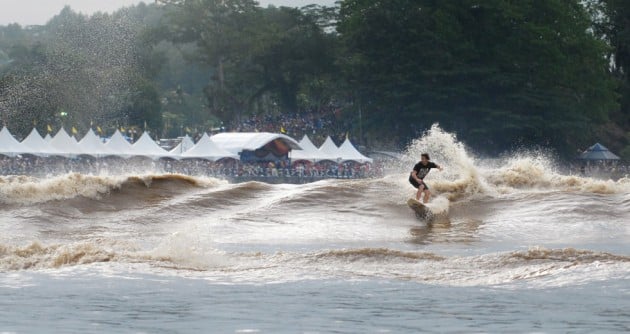 Photo Credit: mohzaid
Photo Credit: mohzaid
Celebrating the natural phenomenon with a variety of watersports including longboat paddling, surfing and paddle-boarding, there’s a little something for everyone at the festival. As always, there’ll be food stalls, cultural performances and even if you’re unable to coast along the waves yourself, it’s always fun to watch!
Getting here: Pesta Benak will be held on the 17th-19th of April this year along the Batang Lupar Waterfront in Sri Aman, a 3-hour drive away from Kuching. Buses to Sri Aman are also available from the Kuching Bus Terminal. Park yourself at the Taman Panorama Benak observation point (an award winning piece of architectecture) and you’ll definitely have a good view.
7. Get Up Close With An Orang Utan
Literally meaning: person-of-the-jungle. Orang utans are uniquely native to the rainforests of Malaysia and Indonesia. A visit to Sarawak wouldn’t be complete without seeing one of these beautifully cheeky creatures at least once!
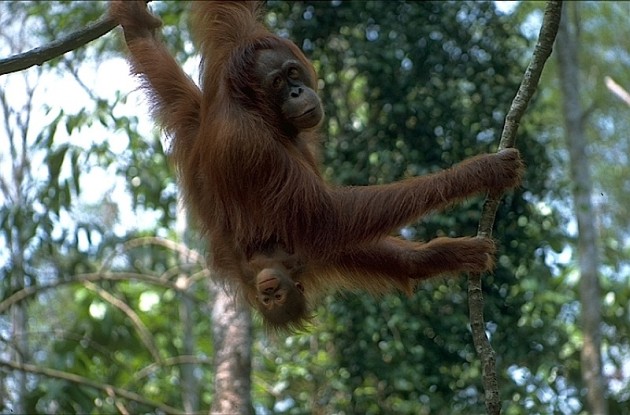 Photo Credit: Borneo Adventure
Photo Credit: Borneo Adventure
Although a visit to any one of the bigger national parks such as Batang Ai or Bako might afford you a glimpse of an orang utan, your best bet to see them up close might be visiting the Semenggoh Wildlife Rehabilitation Centre in Kuching. Come during feeding times, between the hours of 9 to 10 in the morning or 3-3.30 in the afternoon as the orang utans often swing by (literally) for a free meal.
It’s a great opportunity to observe them as they feed and even play amongst themselves. However, do keep in mind that the orang utans are not tame! So remember to exercise caution and follow the instructions of the centre’s guides, its a rehabilitation centre after all.
Getting here: Many tour companies offer packages for tourists to visit the centre and will combine a visit here with some of the other attractions. Additionally, you could take a taxi here from Kuching city and make a day of it as the centre also has nature trails and a plank-walk for visitors to explore.
8. Sway To The Borneo International Jazz Festival
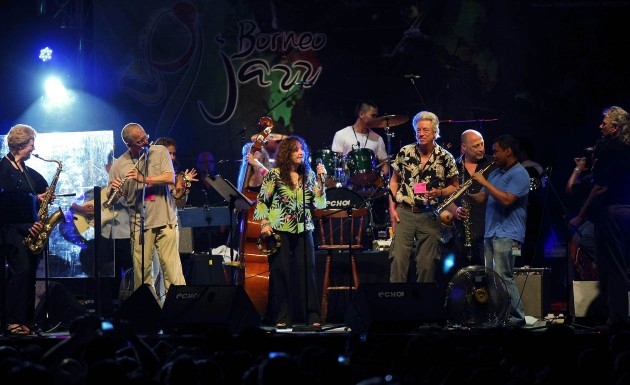 Photo Credit: Parochial Sarawakian
Photo Credit: Parochial Sarawakian
Held annually in the city of Miri, the Borneo International Jazz Festival is now in its 10th year! In light of such a special occasion, the organizers have decided to commemorate the anniversary by having a reunion of bands from the years before. Get your tickets now and sway to the sexy smooth sounds of jazz by internationally recognized artists from around the globe.
Traveller Tips: This year, the festival will take place on the 8th-9th of May. Make a weekend of it and make use of your time during the day to explore the city’s landmarks or even scuba dive! (see item 12 on this list)
9. Eat Kelabit Food Straight From The Jungle
Hailing from Bario, a plateau situated in the highlands in Northern Sarawak, the Kelabit community is just one of the many ethnic groups found throughout East Malaysia. Traditionally, Kelabit food is sourced fresh from the jungle. Several years ago, it might have been difficult to get the ingredients necessary for authentic Kelabit dishes . However, the changing times have seen the Kelabit people migrating into urban cities and thank goodness for that because they’ve brought their food with them!
Both Tribal Stove Restaurant in Kuching and The Summit Cafe in Miri serve authentic Kelabit food (with the latter being more affordable, serving customers ‘economy rice’ style). And while the dishes may seem ‘simple’, they’re all packed with flavor and are utterly unique. So if you simply can’t make up your mind, don’t be afraid to ask the friendly staff for recommendations!
Traveller Tip: Try Nubaq Layaq (mashed red bario rice wrapped in leaf), the shredded beef and the jungle ferns. So much yum!
10. See Wild Proboscis Monkeys At Bako National Park
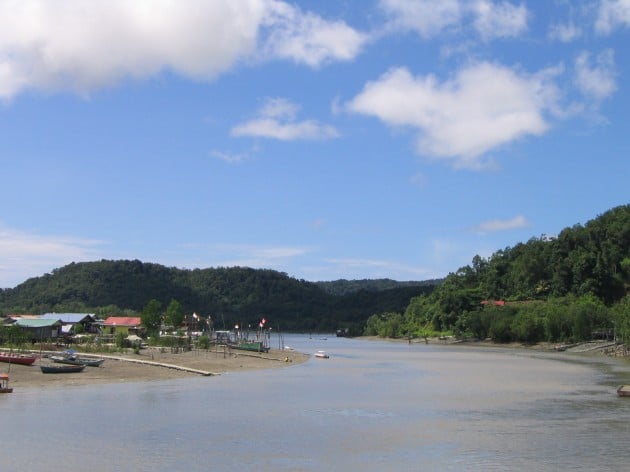 At first glance, Sarawak’s oldest national park may not seem particularly outstanding. However, Bako National Park still stands as one of the best places to observe the incredible variety of vegetation that is unique to Sarawak’s landscape. For such a small area, Bako certainly does contain quite a number of diverse ecosystems from mangrove swamps to rocky cliffs, rainforests and sandy beaches. The park is also abundant in wildlife so if you’re quiet, you may just be lucky enough to spot a proboscis monkey or even a bearded pig rooting around in the jungle!
At first glance, Sarawak’s oldest national park may not seem particularly outstanding. However, Bako National Park still stands as one of the best places to observe the incredible variety of vegetation that is unique to Sarawak’s landscape. For such a small area, Bako certainly does contain quite a number of diverse ecosystems from mangrove swamps to rocky cliffs, rainforests and sandy beaches. The park is also abundant in wildlife so if you’re quiet, you may just be lucky enough to spot a proboscis monkey or even a bearded pig rooting around in the jungle!
Getting here: Bako Village is a 45 minute drive away from Kuching and is also accessible by public bus. From there, you have to take a boat from Bako Jetty to enter the park’s headquarters. Accommodation is available in the park if you wish to stay the night and there are also camping grounds if you choose to rough it out.
11. Visit The Legendary Fairy Cave of Kuching
Situated near the old gold-mining settlement of Bau, Fairy cave is the stuff of local legends. Some say the cave used to house Japanese soldiers hiding from persecution during the war. Others tell the tale of magical fairies, protecting orphaned children living within.
Upon your arrival, you won’t be able to see the entrance to the cave right away. In order to do so, you’ll have to climb a few flights of stairs before arriving within the spectacular cavern of the cave. The limestone cave is certainly beautiful if not a bit eerie. This is in part due to the locals who have placed prayer items at the foot of several deity-like rock formations within the cave itself.
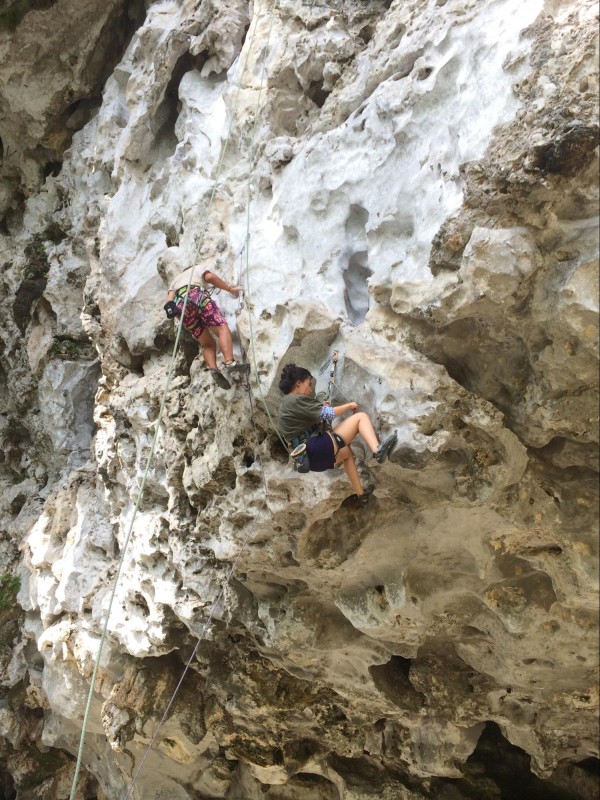 On the outside however, fairy cave is a popular spot with the local rock climbing community. Boasting a large variety routes, the walls here are a great stomping ground for any rock-climbing enthusiast and a challenging but fun endeavour for any beginner. And just in case you’re wondering, the Sarawak Tourism website does indeed note that the walls of fairy cave have fixed hangers, the quality of which have been certified by the International Mountaineering and Climbing Federation (UIAA).
On the outside however, fairy cave is a popular spot with the local rock climbing community. Boasting a large variety routes, the walls here are a great stomping ground for any rock-climbing enthusiast and a challenging but fun endeavour for any beginner. And just in case you’re wondering, the Sarawak Tourism website does indeed note that the walls of fairy cave have fixed hangers, the quality of which have been certified by the International Mountaineering and Climbing Federation (UIAA).
Getting here: This beautiful cave is situated about 40 kilometres from Kuching, a 45 minute drive away. Public transport does not come all the way out here but most tour companies do.
Traveller tip: The cave is surrounded by lush greenery and farmland with some villages in the background but there isn’t much else. So please remember, safety first! The paths within the cave are often slippery and parts of it may be quite dark so remember to bring good footwear and torches. If you’re interested in rock-climbing however, you could always get in touch with Climb Asend, part of the local rock-climbing community.
12. Go Scuba Diving
 Although Sarawak might be better known for its jungles and mountain, both the city of Kuching and Miri are able to lay claim to some absolutely gorgeous diving spots. Oddly enough however, it is due to the fact that these dive spots are relatively unknown that the their beauty has been allowed to flourish.
Although Sarawak might be better known for its jungles and mountain, both the city of Kuching and Miri are able to lay claim to some absolutely gorgeous diving spots. Oddly enough however, it is due to the fact that these dive spots are relatively unknown that the their beauty has been allowed to flourish.
Recent times have seen Miri’s underwater world gaining a name for itself for having some pristine coral reefs and thriving sea-life (check out Miri-Sibuti Coral Reef National Park). The dive scene in Kuching on the other hand has also become increasing popular over the years due to the presence of three japanese world war II shipwrecks just off the coast of Santubong.
Many interesting relics such as torpedos, gun shells and sake bottles can still be seen at the shipwreck sites and it’s always fun when you spot something obscure (my buddy and I came across a typewriter of all things!). So if you’re someone who’s not had the opportunity to go wreck diving before, this would be your chance!
Getting here: There are several dive centres in both Miri and Kuching with different packages to cater to your needs. And if you haven’t gotten your open water license yet, you can approach any of these in order to learn more about becoming a certified diver.
13. Visit a crocodile Farm
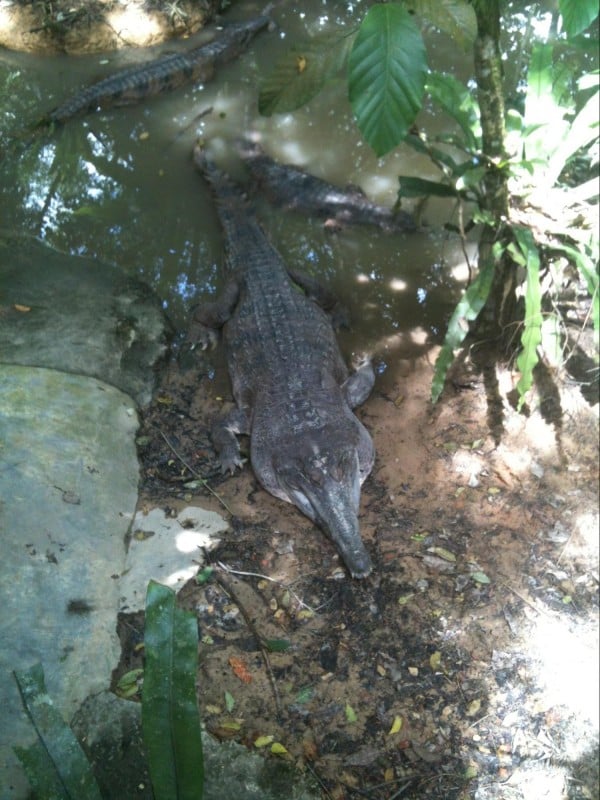 There are two crocodile farms in Sarawak, one in Miri and one in Kuching. Each farm is pretty extensive and not only has an impressive array of crocodiles but also a mini-zoo with a variety of other animals and birds. Plan your visit to coincide with the feeding times and be amazed by the agility of these reptiles as they erupt from the water, to snatch bits of meat dangling on the lines above. Definitely worth a day-trip!
There are two crocodile farms in Sarawak, one in Miri and one in Kuching. Each farm is pretty extensive and not only has an impressive array of crocodiles but also a mini-zoo with a variety of other animals and birds. Plan your visit to coincide with the feeding times and be amazed by the agility of these reptiles as they erupt from the water, to snatch bits of meat dangling on the lines above. Definitely worth a day-trip!
Getting here: Jong’s Crocodile Farm, 29KM, Jalan Kuching – Serian, 94200 Siburan, Sarawak. Miri Crocodile Farm cum Mini Zoo, Lot 164, 24KM, Miri-Kuala Baram Road, 98000 Miri, Sarawak
14. Use A Blowpipe To Hunt At The Sarawak Cultural Village
Situated in the foothills of Mount Santubong, Sarawak Cultural Village is the perfect spot for tourists and locals alike to learn about the ethnic diversity of Malaysia’s largest state. Many indigenous tribes are well represented here with unique ‘houses’ that you would traditionally find belonging to these groups.
Each house has guides dressed in traditional costume, showcasing a unique activity or skillset such as weaving, cooking or even craftsmanship. Visitors are free to participate in any of the activities and you can even test out your ‘hunting’ skills with a blowpipe.
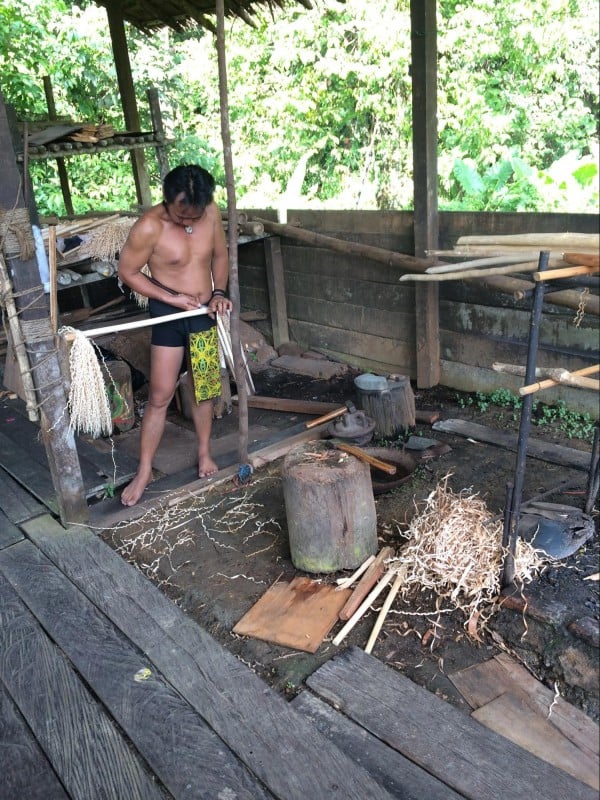 Make sure to catch the village’s award winning cultural show, a highly entertaining cultural display that’s sure to captivate. And before you call it a day, make sure to snag some souvenirs to bring home because the art of the indigenous population is really beautifully unique.
Make sure to catch the village’s award winning cultural show, a highly entertaining cultural display that’s sure to captivate. And before you call it a day, make sure to snag some souvenirs to bring home because the art of the indigenous population is really beautifully unique.
Getting here: Sarawak Cultural Village is roughly 45 minutes away from Kuching city by car. It’s also situated conveniently next door are two beach resorts (Damai Beach and Damai Puri) so you could even opt to stay the weekend!
15. Join In The Gawai Festival
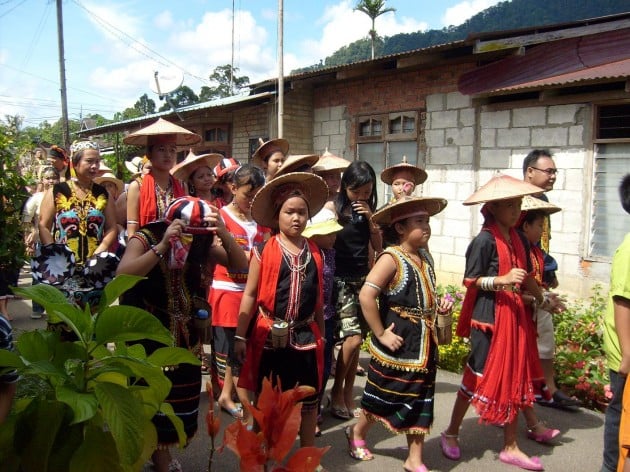 Photo Credit: jenniesyk-spices
Photo Credit: jenniesyk-spices
Celebrated by the Dayak people, Gawai is a thanksgiving festival marking a plentiful harvest. Unlike in West Malayisa, Gawai is an official public holiday in Sarawak and is an integral part of the Dayak culture. The festival lasts two days (31st May-1st June) and is celebrated not only with good food and drink but also with culturally significant rituals and ceremonies, thanking the gods for a bountiful year and asking for their blessings.
Most festivities during this period of time take place back in kampongs; in longhouses where there’s plenty of space for family and friends to share a festive communal meal to mark this joyous occassion.
Getting here: Unfortunately this isn’t the sort of thing with an address, but if you’re in Sarawak long enough, you may just get an invitation to share in this joyous occasion with the good-natured locals!
16. World Harvest Festival
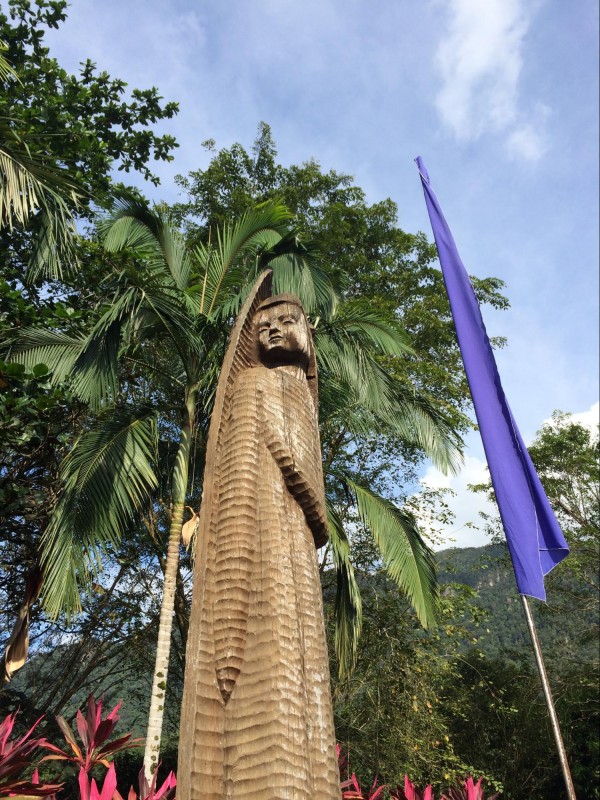 Held in conjunction with Gawai, the World Harvest Festival does not only celebrate the Dayak people but has now come to include many of the different ethnic tribes in Sarawak. Every year the highlight of the festival is the theme play, a re-enactment of specially selected local legends, that uses not just a central stage but the entire Cultural Village as a means to tell a story. Both international and local troupes will be present at the festival this year as well, allowing visitors to learn more about their respective cultures through a variety of workshops and classes.
Held in conjunction with Gawai, the World Harvest Festival does not only celebrate the Dayak people but has now come to include many of the different ethnic tribes in Sarawak. Every year the highlight of the festival is the theme play, a re-enactment of specially selected local legends, that uses not just a central stage but the entire Cultural Village as a means to tell a story. Both international and local troupes will be present at the festival this year as well, allowing visitors to learn more about their respective cultures through a variety of workshops and classes.
In addition to that, another quirky highlight of the festival is the annual Ironman competition. Here, contestants must prove their worth in a series of tests that include blowpipe shooting, tyre flips and rafting! And if watching a bunch of men rip coconuts apart (yup, that’s also part of the competition) isn’t your thing, the Miss Cultural Harvest ethnic beauty pageant will also be staging their finales as part of this year’s line up of events, free for all to watch.
Getting here: This year, World Harvest Festival will be held on the 1st-3rd of May at the Sarawak Cultural Village in Kuching. Do check out the official website for more information.
17. Go On A Homestay
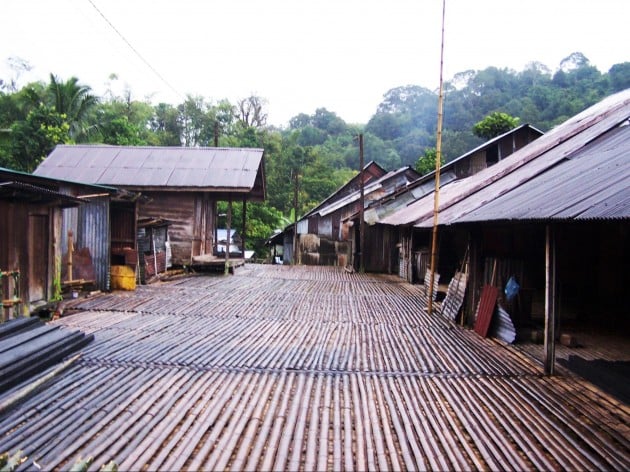 Photo Credit: longhouseadventure
Photo Credit: longhouseadventure
One of the best ways to get to know the local community is to fully immerse yourself in its culture and doing a homestay is one of the best ways to do so. You can find any number of village longhouse homestays in Sarawak via a tour operator or even search them up online.
Depending on which ethnic group you choose, the activities you experience during your stay may differ from host to host as they try to introduce guests to their traditional way of life. However, the one thing in common that you can expect from all homestays is the warm hospitality and generosity of the local people, making the entire experience an unforgettable one.
Getting here: If you’re in Kuching, I would recommend the Annah Rais Bidayuh Homestay. or if you’re in Miri, how about a homestay in the Bario highlands?
18. Enjoy The Borneo Cultural Festival
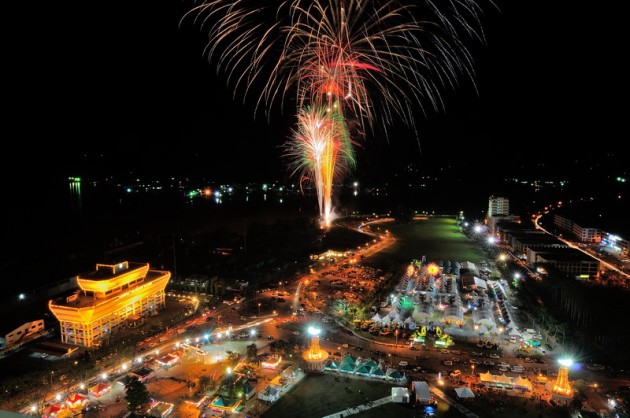 Photo Credit: Sibu Tradex
Photo Credit: Sibu Tradex
Borneo Cultural Festival is one of the biggest celebrations in Sibu. Held annually, the festival lasts a week and celebrates the diversity of the local people through performances, competitions and shows. However, it’s also pretty obvious that the festival has a strong emphasis on food and with so many great examples of Malay, Melanau, Chinese and Dayak cooking on display, you’ll be spoilt for choice!
Getting here: The event is held annually at Sibu Town Square, within walking distance from most hotels.
19. Visit Sibu Central Market
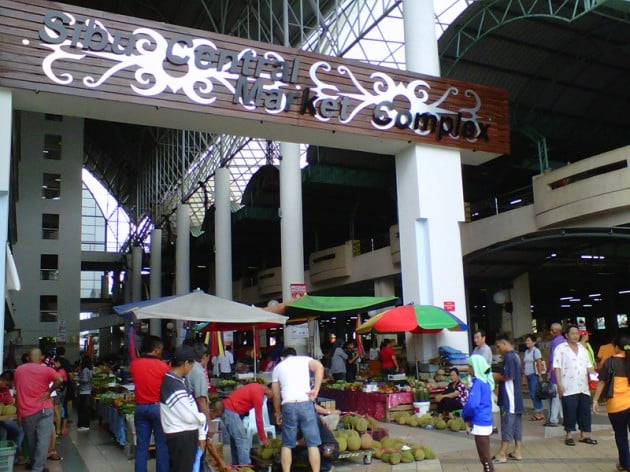 Photo Credit: Sarawak Tourism
Photo Credit: Sarawak Tourism
The largest indoor market in Malaysia, Sibu’s Central Market covers two floors. The ground floor is for vendors to sell their wares and the top is for food. Expect to find a wide range of items for sale here, ranging from fresh vegetables and jungle produce to live poultry wrapped up in newspaper and string. Take a stroll through the well-organized stalls and don’t be afraid to ask the vendors if you’re unsure of how to eat or cook a particular fruit or vegetable.
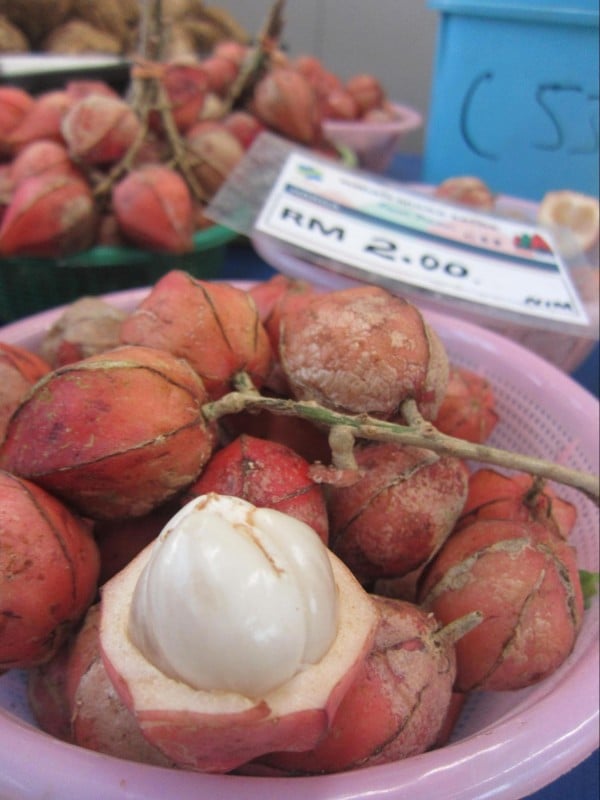 And despite the slight pick-up in tourism, Sibu Central Market is still very much a place for locals to get their everyday necessities so the place may be quite crowded and lively in the mornings but I think that’s all definitely part of the experience!
And despite the slight pick-up in tourism, Sibu Central Market is still very much a place for locals to get their everyday necessities so the place may be quite crowded and lively in the mornings but I think that’s all definitely part of the experience!
Getting here: Sibu Central Market, Jalan Chanel Sibu, 96000, Sibu, Sarawak.
20. Hash Running
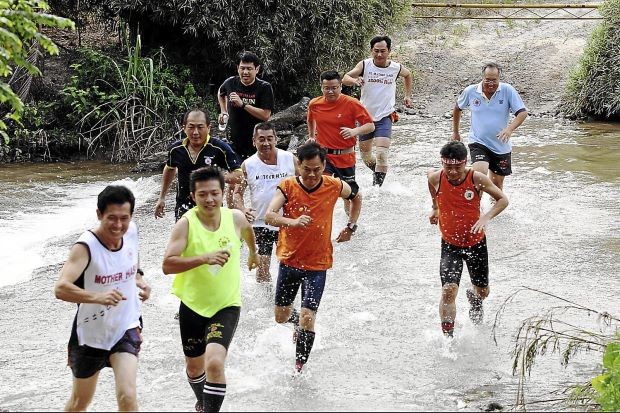 Photo Credit: The Star Online
Photo Credit: The Star Online
“On-On-On!!”, is the cry you’ll hear echoing through the jungle as a group of enthusiastic runners race through the maze of trees, running after their ‘hare’, a running leader who sets the trail for the group. A unique sport that combines athletic ability with the sheer love of running, hashing often involves running across all sorts of terrain from muddy fields to hills and plantations.
The main aim of hashing is, of course, to promote good health. However, another equally important aspect of this sport is to ensure everyone has a good time. It’s tradition for everyone to gather together at the end of a run, have a few drinks, laugh and generally have fun. And although not a sport unique to Sarawak, hash running in the jungles of Borneo would certainly be an interesting if not utterly unique experience.
Getting here: Each major town and city in Sarawak has at least one hash house. For a full list of Hash houses in Sarawak, check out the Malaysian Hash Council website here.
21. Canada Hill, Miri
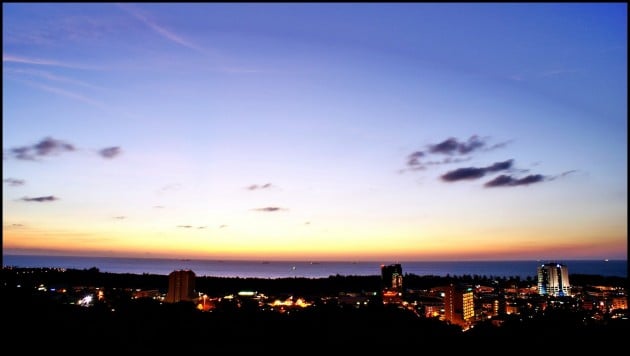 Photo Credit: JDing Photography
Photo Credit: JDing Photography
Home to Miri’s ‘Grand Old Lady’, Miri’s first oil well Canada Hill is not only an important landmark but also a beautiful spot to take a hike with a panoramic view of the city. Visit on a sunny day and make sure to take a moment to learn about the ‘Grand Old Lady’. A petroleum museum is also situated next to this monument, making it the perfect place to learn more about the start of the petroleum industry that has shaped Miri (and to a large extent, Malaysia) into the city it is today.
Getting here: If you’re driving, just search up ‘The Grand Old lady’ on Google maps and it’ll lead you right to the very top of Canada Hill.
22. Indulge In Foochow Food In Sibu
Affectionately known as the Foochow heartland of Sarawak, Sibu town was the first port of call for the hundreds of Foochow Chinese who migrated over from mainland China during colonial rule. Although the Foochow also landed in parts of West Malaysia such as Setiawan, there is certainly a difference in culture between the two cities.
So if you’re lucky enough to visit the town of Sibu, make sure to try these foochow delicacies:
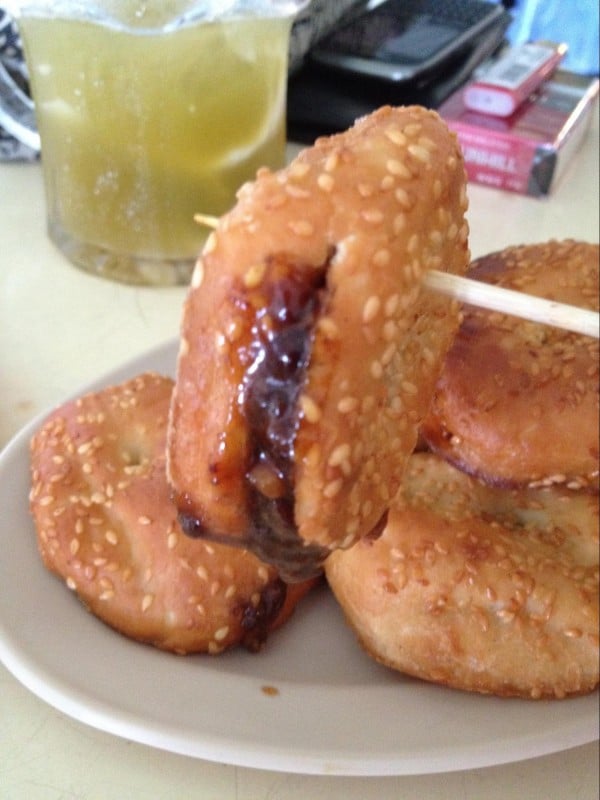 Kompia, a type of bun sprinkled with sesame seeds and traditionally baked in a large urn. This durable buns were once the food of soldiers who would string them around their waists as they marched. Nowadays however, kompia are easily found in coffee-shops and can be had soft, fresh from the oven or fried and stuffed with stewed pork.
Kompia, a type of bun sprinkled with sesame seeds and traditionally baked in a large urn. This durable buns were once the food of soldiers who would string them around their waists as they marched. Nowadays however, kompia are easily found in coffee-shops and can be had soft, fresh from the oven or fried and stuffed with stewed pork.
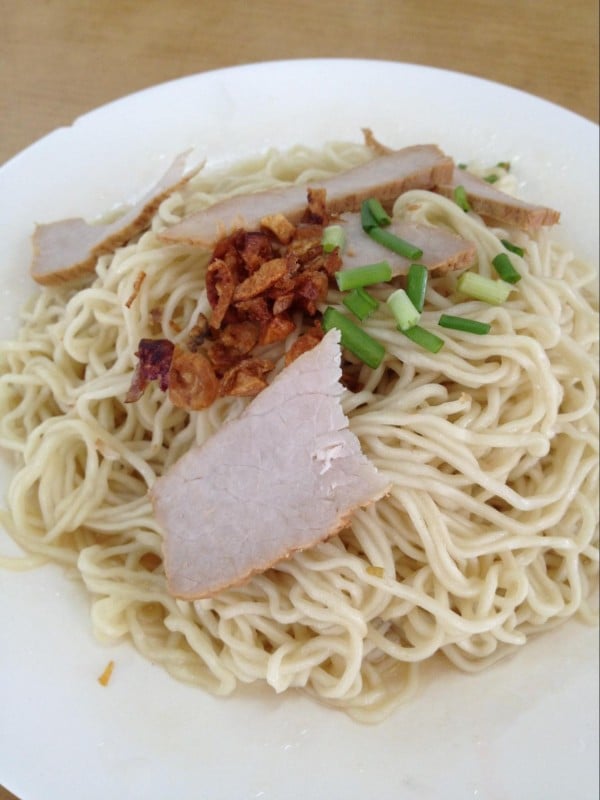 Kampua mee. Traditionally served up in a plate instead of a bowl, the secret to Kampua’s heart-stopping deliciousness is basically pork lard, a lot of it.
Kampua mee. Traditionally served up in a plate instead of a bowl, the secret to Kampua’s heart-stopping deliciousness is basically pork lard, a lot of it.
Okalang. Also known as buah Dabai or black olive (though it’s really not one at all), this black fruit is popular for its creamy (think avocado) texture. Often cooked with a little soy sauce and sugar, this nutritious fruit is unique to Sarawak can be purchased at Sibu Central Market.
23. Eat Sarawak Laksa
Regardless of which state you come from and consequently, which laksa you think is the best, you have to admit that every state’s signature bowl is unique! Sarawak laksa isn’t as tangy as Penang’s or as curry-based as Johor’s but instead has a soup base made from a paste of sambal belacan, spices and aromatics.
Traditionally, a bowl of Sarawak laksa always comes topped with shredded chicken, strips of fried egg, a few prawns, coriander and bean sprouts. It’s spicy but not overly so and just the right thing to wake you up in the mornings and get you ready for the day ahead.
Getting here: Locals will tell you of a hundred different places to get a good bowl but personally, I like the one at Chong Choon Cafe, Lot 121, Section 3, Abell Road, 93100, Kuching.
24. Try Kuching Kolo Mee
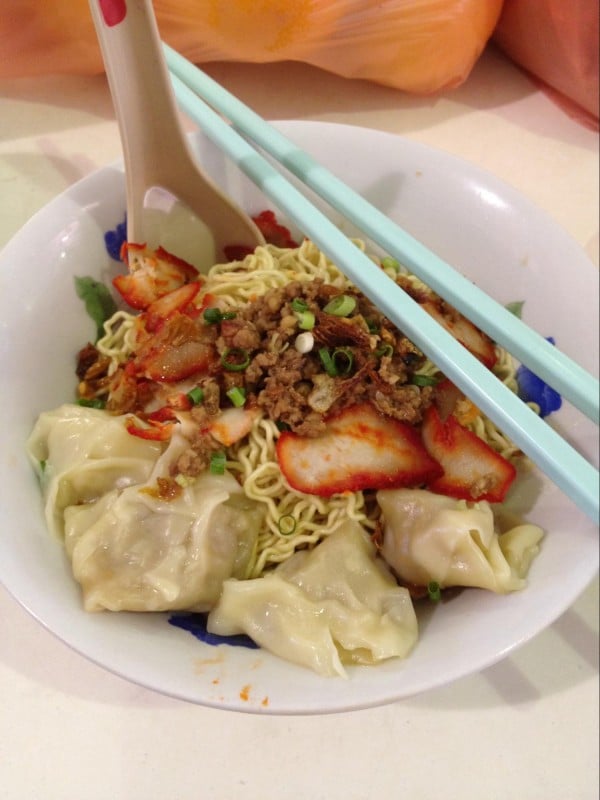 The beauty of Kolo Mee lies in it’s simplicity. It’s a bowl of springy noodles, tossed in a mixture of lard or even char siew oil. Sprinkled with spring onions and a dash of pepper, topped with some sort of protein like minced pork, seafood or even wontons. Many of us grew up with this as a breakfast staple and for most Kuchingites, it will always be an oh-so-sinfully-tasty reminder of home.
The beauty of Kolo Mee lies in it’s simplicity. It’s a bowl of springy noodles, tossed in a mixture of lard or even char siew oil. Sprinkled with spring onions and a dash of pepper, topped with some sort of protein like minced pork, seafood or even wontons. Many of us grew up with this as a breakfast staple and for most Kuchingites, it will always be an oh-so-sinfully-tasty reminder of home.
Getting here: Kolo mee is easily found at most coffee shops in Kuching and again, all locals will have their personal favourites but one of mine is at K.Y. Cafe along Sekama road, it’s a corner lot, almost opposite Rasa Sayang club and it opens late into the night.
25. Climb Mount Santubong In Kuching
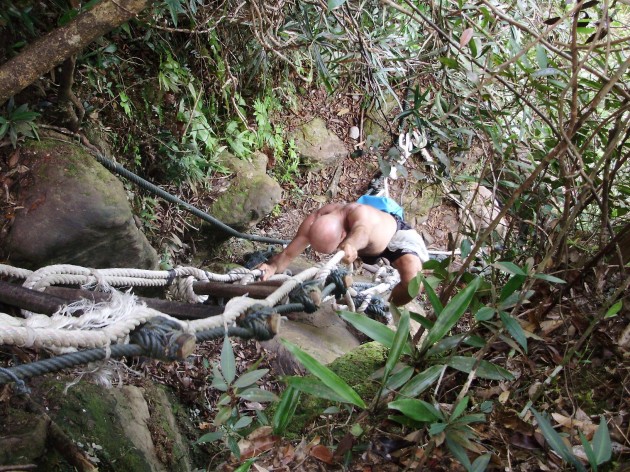 Photo Credit: gadflyketch
Photo Credit: gadflyketch
Named after the legend of Puteri Santubong, local lore says if you look at Mount Santubong at just the right angle, it looks exactly like the pregnant princess, struck down by her sister in a jealous rage. Sure, there may be a air of mystery and romance surrounding the mountain but make no mistake, getting up this mountain isn’t a walk in the park. Parts of the mountain trek are fairly steep and require the use of rope supports in order to get past.
Although the trek is well maintained, trekkers will probably still have to get down and dirty clambering over large rocks and tree roots, but that really is all part of the fun. And for those who are adventurous enough to give it a go, the view once you reach the top is certainly beautiful but nothing beats that sense of satisfaction that you’ve made it!
Getting here: The foothills of Mt. Santubong are about a 45-minute drive from Kuching City. You may park at the canteen/restaurant car park at the base of the mountain and pay a minimal fee to enter. The trek will take about 6-8 hours depending on your level of fitness so start early as it starts to get dark around 5 or 6pm.
26. Explore The Niah Caves in Miri
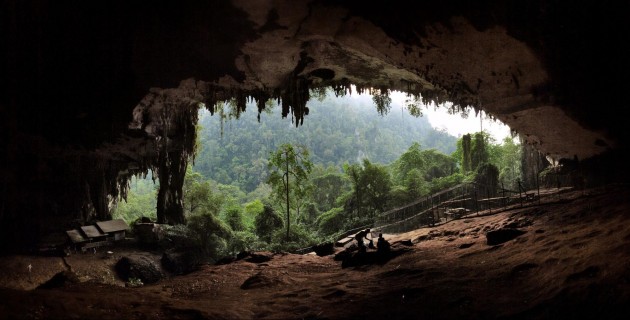 Photo Credit: Wikipedia
Photo Credit: Wikipedia
Being the oldest record of human settlement in East Malaysia, Niah caves is a place of historical significance. The caves are located about an hour’s drive or a two-hour bus ride away from Miri city and can be toured without a guide. Prior to reaching the caves, visitors must take a short boat ride (if you’re tempted to swim, think crocodiles!) and walk through the rainforest, giving them ample opportunity to look out for some local wildlife including hornbills and monkeys. And once you’ve reached the network of caves, do make sure to check out the largest of the caverns ‘Great Cave’ as well as ‘Painting Cave’ where you can see the cave paintings and burial ground left behind by our Malaysian ancestors.
Getting here: Niah Caves is easily found on google maps, however, if you’d like more practical information, please visit the Sarawak tourism website. I do recommend that you bring good footwear as the walking tracks can be quite slippery and torches as the caves are not well lit.
27. Hike Up Mount Singai in Kuching
To be honest, a hike up Mount Singai isn’t really a hike, it’s more climbing the stairs to the very top of a small high-rise! The stairs however aren’t the only thing that set Mount Singai apart from the other treks and mountains. Along the slope of Mount Singai, what originally started out as a small church has now grown into a Catholic Memorial and Pilgrimage Centre (CMPC).
The climb up to the centre is dotted with plaques, illustrating the story of Jesus Christ’s crucification and ultimately leads to a shrine, a longhouse and a beautiful looking church with an open courtyard for prayer and reflection.
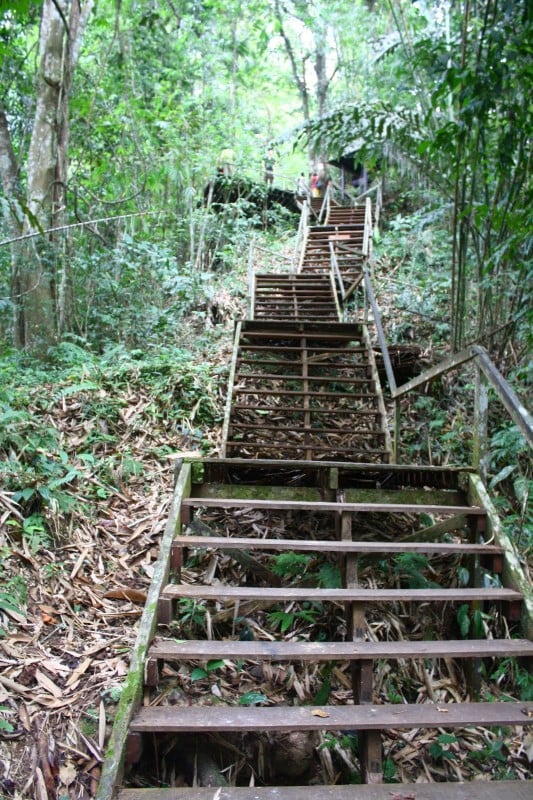 Photo Credit: A peace of Mind
Photo Credit: A peace of Mind
Although going up Mount Singai may seem relatively easy, it’s also most certainly a good workout for the legs (all those stairs!) and a good entry point for those who like to take on tougher treks in the future. Despite its name however, the area is open to people of all beliefs. So all you really need, is the ability to appreciate the serenity of mother nature and the views of the surrounding jungle as you climb higher and higher to the top.
Getting here: The junction to the centre is located along the Singai-Tondong road and is marked with a signboard. Visitors heading here from Kuching may take the Kuching-Matang road headed to Bau. For more specific instructions on how to get here, please check out Sarawak-Vacation-Destinations.
28. Trek To Jangkar Waterfalls in Kuching
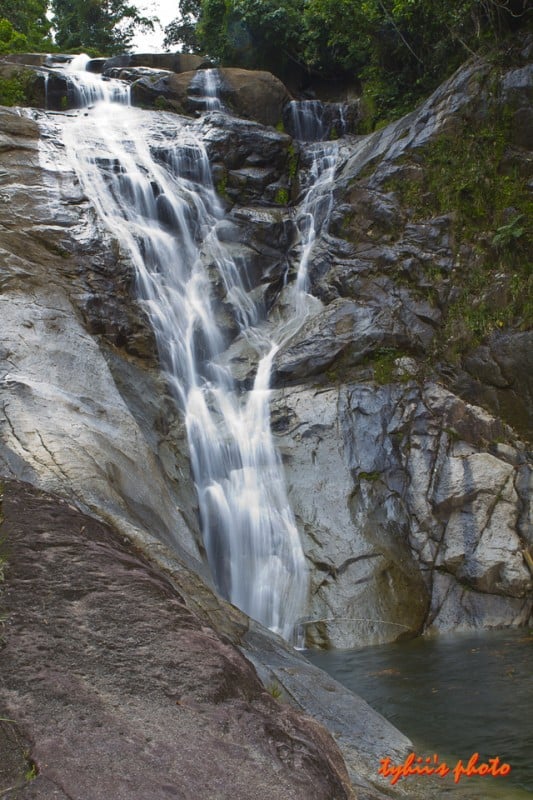 Photo Credit: Tyhii
Photo Credit: Tyhii
Kampung Jantan, where these waterfalls are situated, may be a little out of the way for most Kuching folk but the beauty of Jangkar certainly makes the bumpy trip out here, worth it . The waterfalls here are majestic to see and the view from the top of the second waterfall is in a word, breathtaking.
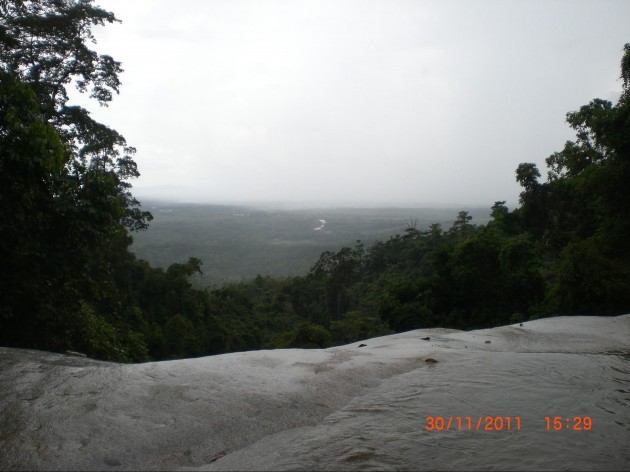 According to local guide Ben, there are over 20 waterfalls in total in Jangkar although only 7 of these are frequented by visitors. For a very reasonable fee, Ben and his neighbours will not only guide you to Jangkar but will even make you a traditional-style lunch of bamboo chicken and rice.
According to local guide Ben, there are over 20 waterfalls in total in Jangkar although only 7 of these are frequented by visitors. For a very reasonable fee, Ben and his neighbours will not only guide you to Jangkar but will even make you a traditional-style lunch of bamboo chicken and rice.
The trek to the first of the fall takes about an hour and although it may get a little humid, a cool dip in the pools of the falls are just the thing to freshen you up. Thrill seekers are also known to leap off the side of the waterfall into the pool below and if you ask Ben nicely he may even dive into the water himself!
Getting here: Ben actually has a facebook page that he sometimes frequents but it might be a lot easier to just give him a ring (+60)148999158. The coordinates to the waterfall can also be found here.
29. Bario Food Festival
Otherwise known as Pesta Nunuken, the Bario Food Festival is a celebration of the cultural heritage that is Bario Highlands. Home to the Kelabit people, Bario is one of the last few places where sustainable farming is still done the traditional way. Although, the Kelabit do not shy away from modern innovations, (embracing tourism, the internet, computers and the like) it’s great to know that the Kelabit people here are preserving their heritage.
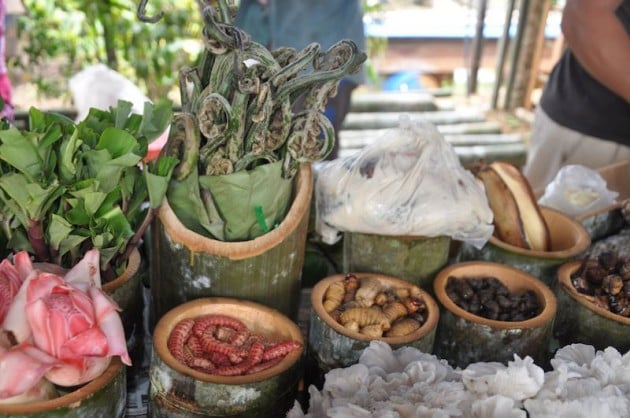 Photo Credit: expatgomalaysia
Photo Credit: expatgomalaysia
Although the food stalls won’t number that of the festivals mentioned above there will still definitely be lot of exotic, wholesome dishes to try. There’s trekking during the day to burn off all you’ve eaten, as well as nightly performances and games that go on into the night. Come with an appetite, a sense of adventure and witness a way of way of life that has stood the test of time.
Getting here: MasWings, the regional branch of Malaysian Airlines runs flights from Miri and Marudi to Bario, several times a week. Longhouse homestays are available during the festival and more information will be available closer to the date (30th July-1st August) so do check out their facebook, Bario Food Festival for updates. You may read also read some great firsthand accounts of the festival here and here.
30. Dip In The Annah Rais Hot Springs
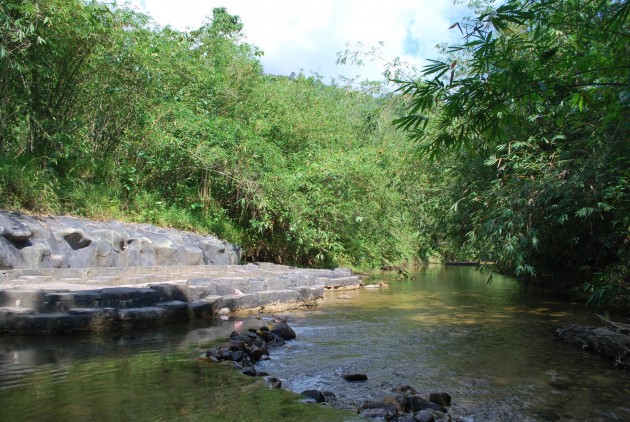 Photo Credit: transannie
Photo Credit: transannie
Who would have known that we’d have hot springs in the middle of the jungle? The Annah Rais Hot Springs were discovered by locals ages ago but have only become popular with the public over the past 10 years or so.
Locals believe that a dip in the hot water is good for the body and helps to improve blood circulation. This is done by alternately dipping yourself in the hot pools and also the cold river just beside the springs, allowing your blood vessels to expand and constrict accordingly. Who knows if the hot springs are truly medicinal but they’re definitely therapeutic, just imagine soaking away all that accumulated stress and fatigue from your everyday 9 to 5. Bliss!
Getting here: Follow a tour operator or drive yourself (the journey will take about 1.5 hours). You can make your way to the Annah Rais longhouse (Jalan Borneo Heights, Kampung Annah Rais, Padawan, 71, 94200, Kuching, Sarawak) and follow the signs from there. This article right here also has pretty good driving directions.
31. Travel To The Miri City Mayfest
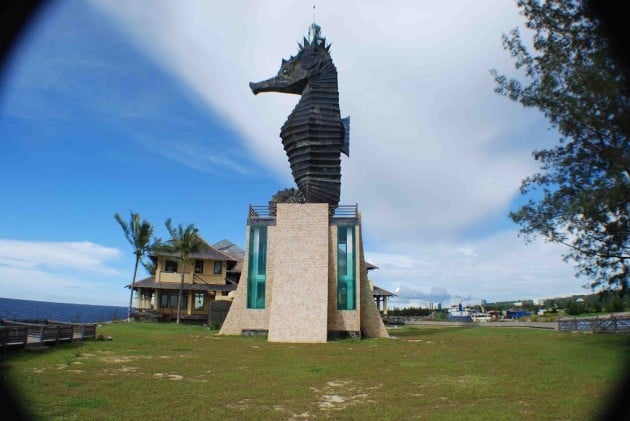 Photo Credit: keenamfoo
Photo Credit: keenamfoo
The 20th of May 2005 was the day that Miri was declared as a city (it used to be classified as a town). And In memory of that day, the Miri City Council holds an annual ‘Mayfest’.
For the entire month of May, Miri will be a hive of activity. Various charities, organizations are welcome to hold events during this time and previous celebrations have seen over 50 submissions. There will be trade fairs, food fairs, dances and even competitions (think everything from darts to fishing) so there’s something for everyone! Get involved with the community and make sure to keep an eye out for the fireworks that light up the sky on city day itself.
Getting here: Do check out Miri Council’s official website for more details if you’d like to submit some suggestions yourself and keep updated as Miri’s City Day is not always celebrated on May 20th but on the weekend closest.
32. Eat a Sago Worm
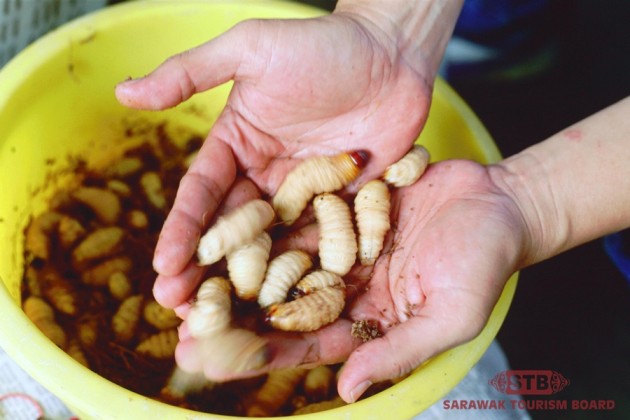 Photo Credit: Sarawak Tourism
Photo Credit: Sarawak Tourism
Sago trees were once considered the bread and butter of the Melanau people so although not exactly common, these protein-rich sago worms are still considered a yummy delicacy among native Sarawakians. I’ve even heard that you can even find them being fried up in certain hawker stalls in Sibu! And honestly, once you ignore the fact that you’re chomping down on a worm, it does actually taste like chicken. So close your eyes, yank off that worm’s head, chew and swallow so you can say that you’ve done it once in your life!
Getting one: In Kuching, these unique ‘bites’ can be found on the weekends at local markets such as Saratok market or Kubah Ria.
Traveller tip: It may be a little tough to take on one of these things live so I’d actually recommend that you get the cooked/dried ones. (if you have the chance, get the ones with teriyaki sauce!)
33. Take a stroll along Kuching Waterfront
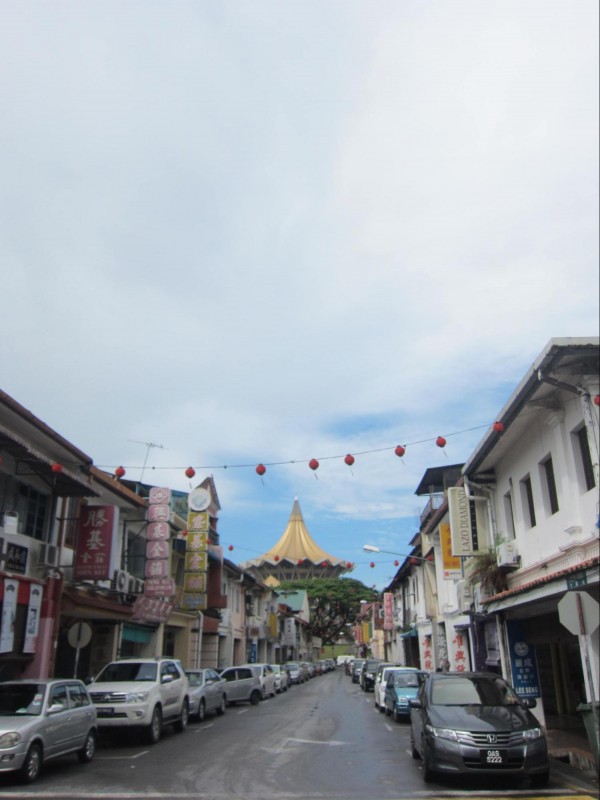 Taking a walk along Kuching Waterfront is a great way to appreciate some of the city’s great architecture and old world roots. On one side of the waterfront, you have quaint old shophouses lining the streets. And on the other, just across the Sarawak river, you have the grand Astana and eye-catching DUN (Dewan Undangan Negeri) building. A walk here can be quite educational as well as there are several plaques along the way, explaining bits and pieces of Kuching’s history and even a small Chinese museum at one end.
Taking a walk along Kuching Waterfront is a great way to appreciate some of the city’s great architecture and old world roots. On one side of the waterfront, you have quaint old shophouses lining the streets. And on the other, just across the Sarawak river, you have the grand Astana and eye-catching DUN (Dewan Undangan Negeri) building. A walk here can be quite educational as well as there are several plaques along the way, explaining bits and pieces of Kuching’s history and even a small Chinese museum at one end.
While the waterfront is certainly beautiful during the day, make sure to drop by at night when the waterfront really comes alive. The Astana and DUN building are lit up beautifully and the entire walk is scattered with great little food stalls, lively buskers and young children playing with the fairy light spinners sold along the walk.
Getting here: The kilometre long waterfront stretches from Jalan Tunku Abdul Rahman to Jalan Gambier. Start at the end near Riverbank Suites and make your way down past the chinese museum all the way to the square tower and crocodile statues at the end. Deviate into Carpenter Street or the old Courthouse across the road for some serious good eats and end your walk at Plaza Merdeka, the perfect place to cool off after a walk. Or alternatively, take a look at item No. 34..
34. Take a sampan ride
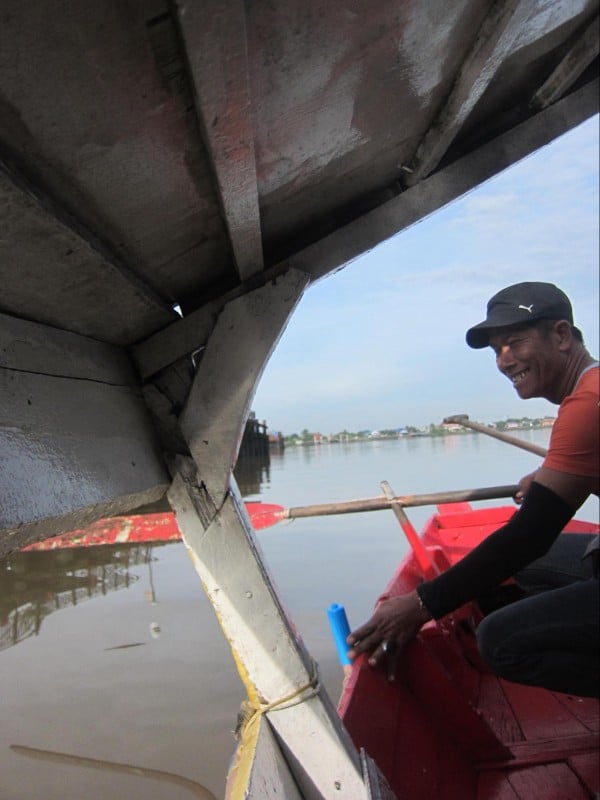 Just like eating laksa or kolok mee, I’d consider riding a sampan (water-taxi) part of the ‘full’ Sarawakian experience. Sure this method of travel may seem a little antiquated but keep in mind that locals do still use this as a quick way of getting across river! From the pier nearest the 7-11 at Kuching Waterfront (look out for the McDonald’s Advertisment), you can take a sampan across the river to Kampung Gerisik on the opposite bank for a minimal fee. Experience river travel as it was back in the day, enjoy the ride and most importantly, don’t fall in!
Just like eating laksa or kolok mee, I’d consider riding a sampan (water-taxi) part of the ‘full’ Sarawakian experience. Sure this method of travel may seem a little antiquated but keep in mind that locals do still use this as a quick way of getting across river! From the pier nearest the 7-11 at Kuching Waterfront (look out for the McDonald’s Advertisment), you can take a sampan across the river to Kampung Gerisik on the opposite bank for a minimal fee. Experience river travel as it was back in the day, enjoy the ride and most importantly, don’t fall in!
Getting here: Kuching Waterfront, Jalan Main Bazaar, 93000, Kuching. Just make sure to head towards the end of the waterfront that’s nearest the cat fountain. There are several other jetties lining the waterfront each with boatmen heading to different villages.
Traveller tip: Kampung Gerisik has a lot of great food at night (check out Barok Bistro) and is the perfect place to try out item 35 on this list.
35. Try Kek Lapis
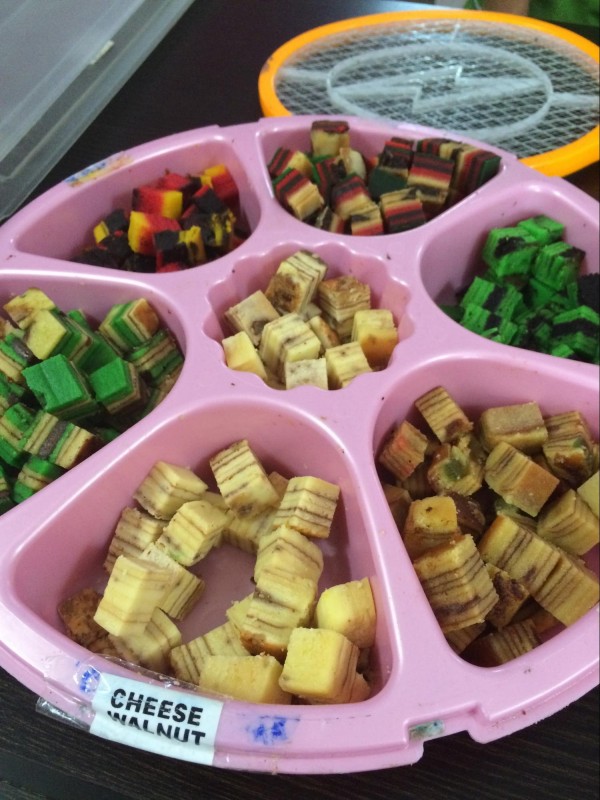 Like the Lamington to Australia or the Victoria Sponge to Great Britain, the words kek lapis have become synonymous with Sarawak. What initially started out as a relatively simple, two-toned multilayered cake has evolved and you can now find kek lapis in all colors and designs. The range of flavors is huge and I’m always incredibly fascinated by the creativity of our local bakeries. From your ‘run-of-mill flavors’ like Kek Lapis Buku, Kek Cadbury and Kek Masam-Manis to the more exotic like Kek Harimau Malaysia (absolutely yummy by the way!) and Kek Sambal, you’ll definitely be able to find something that tickles your fancy!
Like the Lamington to Australia or the Victoria Sponge to Great Britain, the words kek lapis have become synonymous with Sarawak. What initially started out as a relatively simple, two-toned multilayered cake has evolved and you can now find kek lapis in all colors and designs. The range of flavors is huge and I’m always incredibly fascinated by the creativity of our local bakeries. From your ‘run-of-mill flavors’ like Kek Lapis Buku, Kek Cadbury and Kek Masam-Manis to the more exotic like Kek Harimau Malaysia (absolutely yummy by the way!) and Kek Sambal, you’ll definitely be able to find something that tickles your fancy!
Traveller Tip: If you’re in Kuching, I would recommend the cakes at Dayang Salhah in Kampung Gerisik in Kuching (if you buy at least 3, they’ll even package your cakes into box to carry onto your flight) and if you’re in Miri, do check out Habibi Kek Shop for all your layer-cake needs.
36. Eat Dayak Food
The term Dayak loosely refers to the indigenous people of Borneo and actually encompasses over a hundred ethnic subgroups, each with their own unique culture. Traditional Dayak foods such as Umai (think ceviche but differently spiced), ayam pansoh (chicken cooked with herbs in bamboo) and kasam babi (cooked fermented pork) may sound rather odd at first but are in truth, absolutely delicious!
It’s not just the proteins that are good though, even our local veggies such as cangkuk manis (star gooseberry) and midin (a type of fern) are must tries too. And Just in case you’re wondering, the dayak people do indeed have their own alcohol beverage known as Tuak or rice wine.
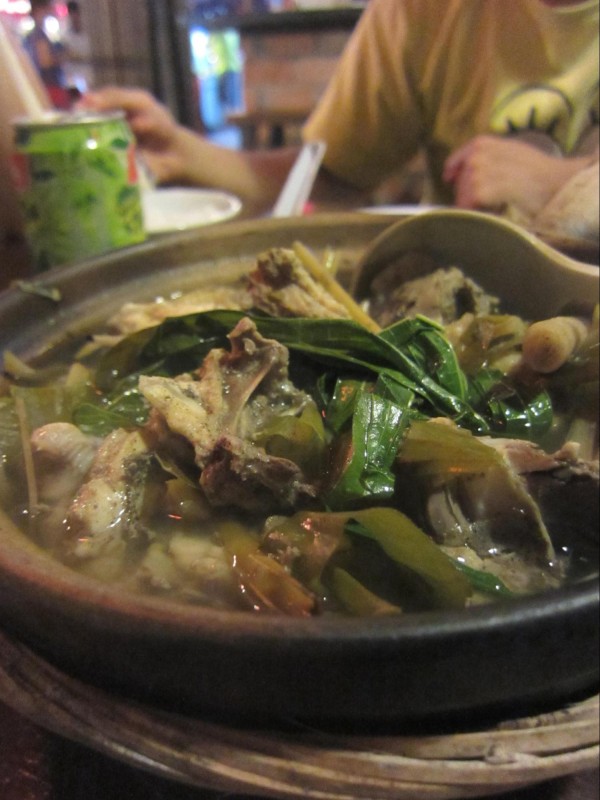 Homey and comforting, eating dayak food is a must! Give it go the next time you see a Dayak stall or restaurant and you can say that you’ve tasted the food of the headhunter tribes of Borneo.
Homey and comforting, eating dayak food is a must! Give it go the next time you see a Dayak stall or restaurant and you can say that you’ve tasted the food of the headhunter tribes of Borneo.
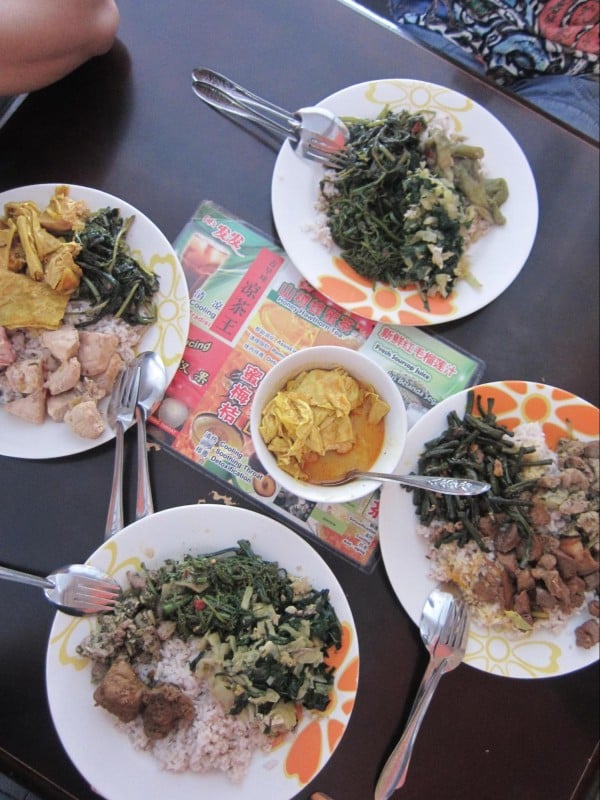 Traveller Tip: If you’re in Kuching, Patz Dayak Home-cook Special located at Full 3 food-court in Stutong serves up mouth-watering food (economy rice style) at really affordable prices. Aunty Pat, the cook and proprietor is passionate about her food and will be more than happy to explain all the dishes to you! And if you’d like to try tuak, there’s always Ruai Bar or The Dyak. The latter not only serves drinks but also does a yummy dessert of fermented rice, tuak and vanilla ice-cream. *drool*
Traveller Tip: If you’re in Kuching, Patz Dayak Home-cook Special located at Full 3 food-court in Stutong serves up mouth-watering food (economy rice style) at really affordable prices. Aunty Pat, the cook and proprietor is passionate about her food and will be more than happy to explain all the dishes to you! And if you’d like to try tuak, there’s always Ruai Bar or The Dyak. The latter not only serves drinks but also does a yummy dessert of fermented rice, tuak and vanilla ice-cream. *drool*
37. Ride A Buffalo At Pesta Babulang
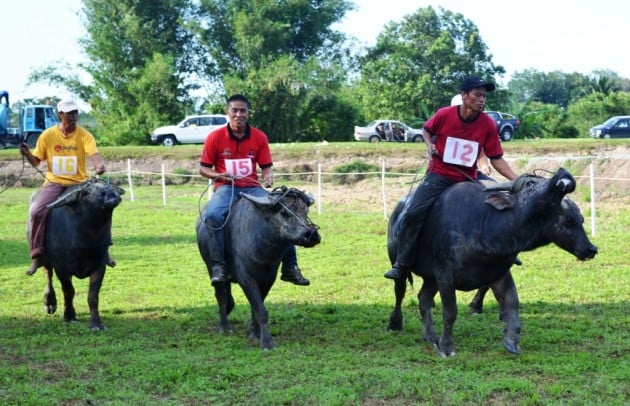 Photo Credit: Sarawak Tourism
Photo Credit: Sarawak Tourism
Now in it’s 12th year, the Babulang festival is a huge annual celebration held by the Bisaya people up in Limbang, one of Sarawak’s northernmost towns. And although the Babulang festival has its roots in the Bisaya culture, it has now become famous for something else: BUFFALO RACING! Teams from the surrounding areas (Brunei and Sabah) meet in Limbang for this yearly event, showing off their skills in this time-old tradition.
As with all festivals there are always side events for everyone to participate in and enjoy. The festival is a great way to get to know the Bisaya people (who were originally from the Philippines). Through beauty pageants, competitions, dances and handicraft fairs, the culture of the Bisaya people is wonderfully exhibited. And if that’s not reason enough to visit Limbang, honestly, I mean.. where else could you ride (or try to) a water buffalo?
Getting here: MasWings operates flights to Limbang from Miri several times a week. In conjunction with the festival, the Bisaya association also arranges travel packages and tours for guests, making it a lot easier for tourists to travel around.
38. Watch The Sibu Big Bike Week
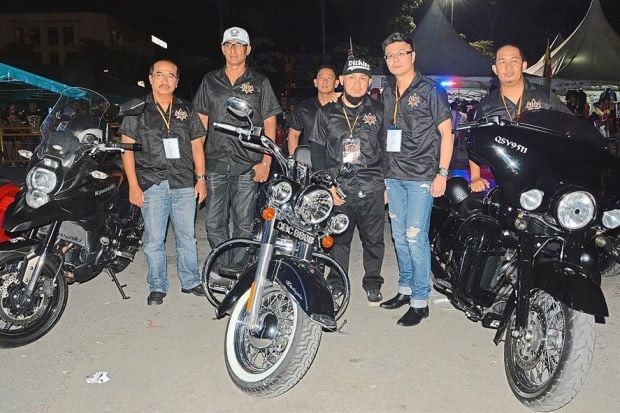 Photo Credit: The Star
Photo Credit: The Star
Organized by the Razz Chopper Motor Club, Sibu Big Bike Week (or rather, weekend) is the perfect place for passionate bikers to get together. With over 2000 bikers coming in from all over Asia to participate, last year’s Big Bike was a huge success. This event isn’t just for bikers though, with plenty of side-events such as BMX and paintball, non-bikers have lots to see and do as well. And yes, although Sibu Big Bike Week may seem like a different sort of cultural celebration from the usual stateside celebrations, the festivities will definitely be something to keep an eye out for as the biker community bring forth a new aspect of modern Sarawakian culture for the public to enjoy.
Getting here: The event will take place in Sibu town on the 4th-6th of December 2015. Do check out The Razz Chopper Motor Club facebook page here for updates. And if you’d like to know more, please check out this news article by The Borneo Post.
39. Witness The Sarawak Regatta
 Photo Credit: AsianItinerary
Photo Credit: AsianItinerary
Dating back to the time of the White Rajah, James Brooke, the Sarawak regatta is a majestic event that sees longboat teams from all over East Malaysia and even Brunei race madly down the Sarawak river. Join the crowds lining the banks of the river, cheering on their favourites and watch as the skillful rowers move in unison, propelling their colorful longboats towards the finish line.
Getting here: The regatta is held along the Sarawak river and a great vantage point would be along the Kuching Waterfront, stretching from Jalan Tun Abdul Rahman to Jalan Gambier.
40. Attend The Mukah Kaul Festival
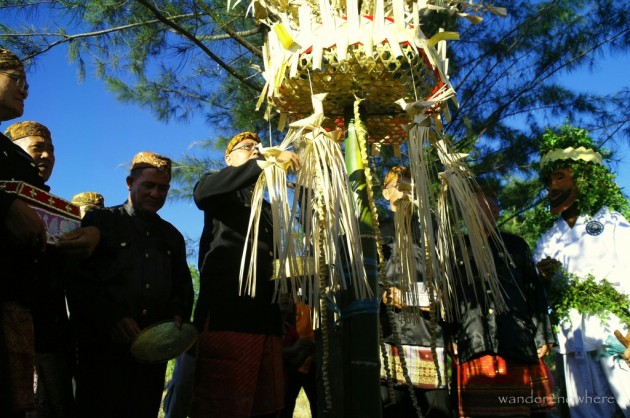 Photo Credit: Noel Lau
Photo Credit: Noel Lau
In the past, Kaul was a ceremony of religious significance, held by the Melanau people appease the spirits of the earth and water and provide a ‘cleansing’ of sorts. Nowadays however, Kaul is still celebrated with the same weight and importance, just with a shift in focus in not only keeping tradition alive but also in providing an opportunity for reunions. The festival lasts a week and the organizers pay great attention to detail to ensure that the old rituals such as the procession of the Seraheng (offering basket) lead by the Bapak Kaul (head of the festival) are done correctly.
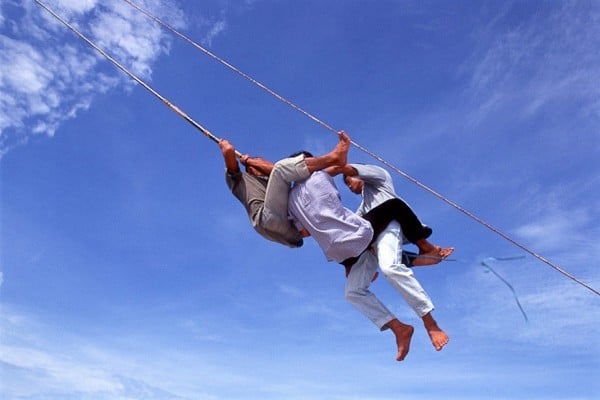 Photo Credit: Sarawak Tourism
Photo Credit: Sarawak Tourism
The festival also showcases a variety of traditional games, the most famous of which is the tibou. Tibou is a traditional game where groups of young men dive from wooden scaffolding to catch hold of a large bamboo swing high in the air, clinging on for dear life. A definite adrenaline rush for those visitors willing to give it a go!
Getting here: The festival is held annually in Mukah and organized by the Melanau Mukah Association, do check out the Sarawak Tourism Website for contact information. If you need more convincing to attend the festival though, please check out these wonderfully passionate articles on Kaul by wander2nowhere and The Borneo Post.
41. Fly A Kit At The Borneo International Kite Festival
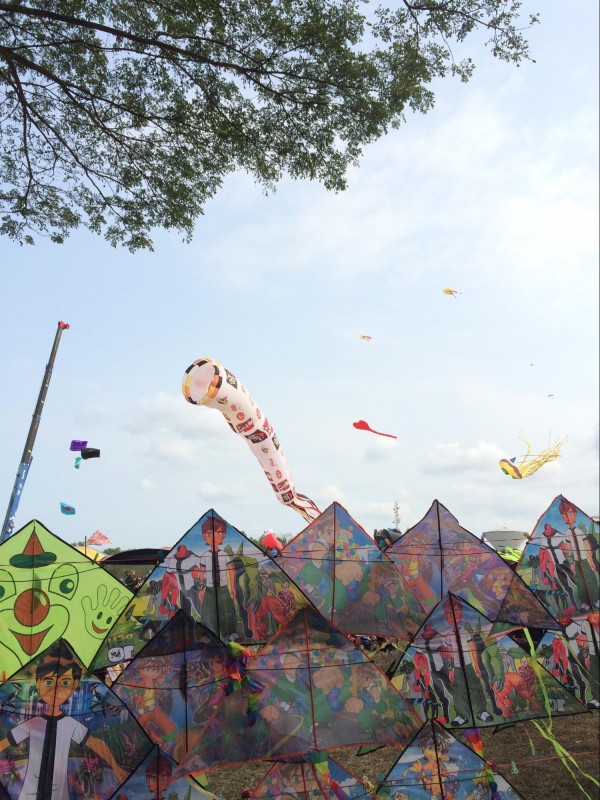 Held in Bintulu, the international kite festival is a colorful event, bringing kiters together from all over the world. The festival, held at old Bintulu airport is the perfect venue for kite-flying enthusiasts as the windy conditions have even allowed records to be broken in past years! Watch as huge kites are buffeted by the wind (how did they even get up there in the first place?) while disciplined teams skillfully control their kites to fly together in perfect formation. Its the perfect event for a day out, especially for the young and the young at heart as they’ll surely be amazed by all they see!
Held in Bintulu, the international kite festival is a colorful event, bringing kiters together from all over the world. The festival, held at old Bintulu airport is the perfect venue for kite-flying enthusiasts as the windy conditions have even allowed records to be broken in past years! Watch as huge kites are buffeted by the wind (how did they even get up there in the first place?) while disciplined teams skillfully control their kites to fly together in perfect formation. Its the perfect event for a day out, especially for the young and the young at heart as they’ll surely be amazed by all they see!
Getting here: The event will be held at the old Bintulu Runway this year on the 1st of September 2015. At the time of writing, the details on the official event website have not yet been updated for this year, however the logistics of the event remain the same and you can check them out on BorneoKite.
42. Check Out The International Bornean Frog Race
As the name might suggest, the main highlight of this event is actually race but just not quite in the way you might imagine it.
Around the world, almost a third of amphibians have gone on the endangered list. In light of this issue, conservationists around the world have decided to hold a Save-the-Frogs day to raise awareness on their plight. So, in conjunction with this world awareness day on the 25th of April, photographers, amateur and professional alike, will go running off into the foothills of Kubah National Park for two hours, in search of frogs to photograph! Participants are not required to have a DSLR and even camera-phones are acceptable.
Prizes will be awarded to those who have managed to capture the most number of frogs, the rarest of species and the best looking photograph. And even if you’re not into racing, event is also great for anyone wishing to learn more about amphibians and nature photography as there will be exhibitions and workshops held throughout the day.
Getting here: The race will be held at Kubah National Park. Do check out the official event website for more details on how to get there as well as their facebook page.
43. Go Rafting At Padawan Raft Safari
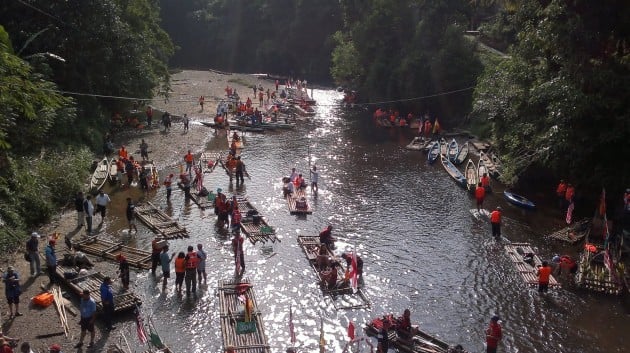 Photo Credit: Kalkenyalang
Photo Credit: Kalkenyalang
Located in the district of Padawan, the event is flagged off at Kampung Danu with the race ending at Kampung Git. Competitors are required to use bamboo rafts strung together with rope while those who wish to enjoy a more leisurely paddle downstream may kayak.
Hundreds of people attend the event every year not only to compete but also to enjoy the opportunity for some splashing around, something that many might not have been able to afford on their own. Homestays at Kampung Annah Rais are much cheaper during this festival and even the rafts used in the race have been provided by the organizers in previous years. And if you haven’t gone rafting before, the Padawan River Race is an opportune time for people to get together and bond over the experience. So why not give it a go this year with your family, friends or even your colleagues? Just make sure to register early to book a raft for your team!
Getting here: Do check out the Sarawak Tourism website here for contact details if you’d like to register your team.
44. Go on a Sketchcrawl in Kuching
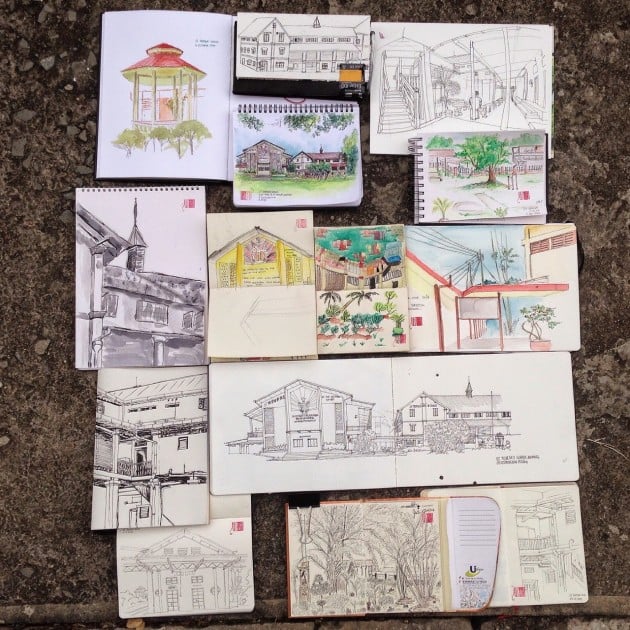 Photo Credit: Urban Sketchers Kuching
Photo Credit: Urban Sketchers Kuching
A sketchcrawl is where a group of artists get together at certain location and draw ‘live’, capturing what is seen directly in front of them. Such gatherings are hosted regularly by the Urban Sketchers of Kuching and all are welcome to participate as individuality is much appreciated. With the aim of telling a story about their surroundings, sketchers are encouraged to let their creativity flow and all forms of art media are allowed at these get-togethers.
So whether you’re a full-time artist or someone who just enjoys doodling, why not meet up with other like-minded individuals and enjoy capturing ‘snapshots’ of urban life in Kuching, you never know what beautiful work you might be inspired to create!
Getting here: The Urban Sketchers regularly event updates on their facebook page and you can even check out the art of some of their members.
45. See the Rafflesia flower in bloom
You may have seen in books and on our local stamps but I bet there aren’t many of us who would’ve seen a Rafflesia in person.
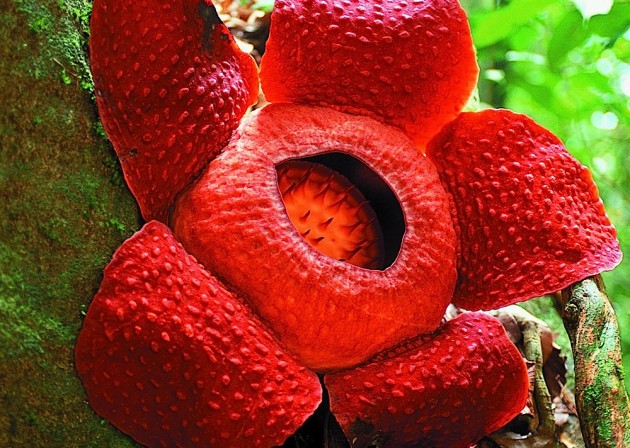 Photo Credit: Borneo Adventure
Photo Credit: Borneo Adventure
The Rafflesia flower is the heaviest flower in the world. A flower in bloom can weigh up to 10 kilograms and bloom to a full metre in diameter. It spends 9 months as a bud (not all buds will get the chance to flower) but only stays in bloom for about 7 days, making this beautiful flower rather difficult to find. However, one of the best places to spot one of these flowers, is in the Lundu district of Sarawak, in Gunung Gading National Park. The park itself is a haven for nature lovers with several treks and climbs to conquer but what all tourists come here for, is a glimpse of this unique parasitic flower. Those who have seen the Rafflesia say that it smells strongly of rotting meat but that doesn’t seem to deter anyone from going in search of it, in fact it seems to make it all the more appealing!
Getting here: Gunung Gading National Park is located about a 2-hour drive away from Kuching and the Sarawak tourism website provides excellent tips on how to get to Gunung Gading National Park by public transport.
Traveller Tip: Do make sure to call up the park rangers in advance, (+60)82 735144, as they would know best when one might catch this flower in bloom.
46. Go Dolphin Watching
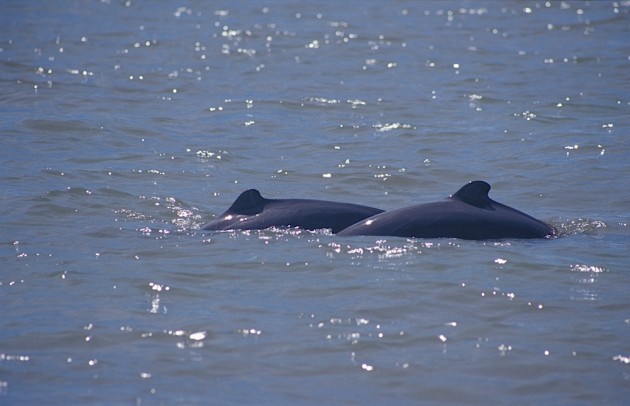 Photo Credit: Borneo Adventure
Photo Credit: Borneo Adventure
The Irrawaddy dolphins are an endangered species. Named after a river in Myanmar, Irrawaddy dolphins are not a true river dolphins, but are more commonly found among coastal beaches and rivers around Borneo and can be sighted at the mouths of the river Salak and Santubong near Kuching city.
Sign up with a local tour operator who will bring you on a cruise around these areas and try and spot these rare creatures frolicking around in their natural habitat. You’d be hard-pressed to catch them anywhere else!
47. Visit Serikin Market
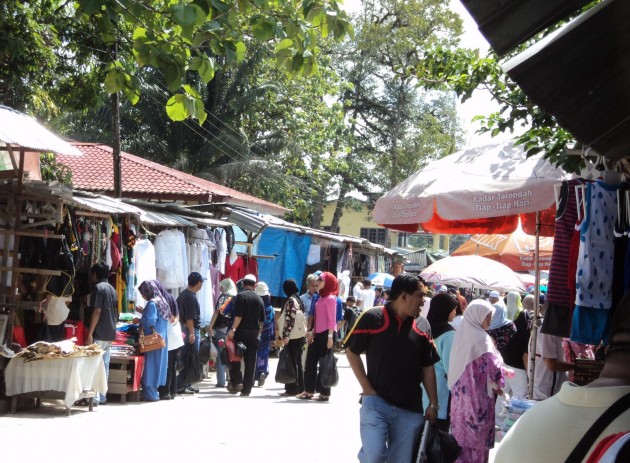 Photo Credit: travelogueasia
Photo Credit: travelogueasia
Serikin market is held every weekend at Kampung Serikin Jagoi, close to the border between Sarawak and Indonesia. Unlike other urban markets, it’s this close proximity that makes this weekend affair so special as it allows Indonesian traders to cross over with ease. Visitors can find any number of Indonesian traders operating here, selling an array of items that range from decorative woodwork to plants, fabrics and traditional-style hats, all at a reasonable (cheap) prices.
The drive into the countryside headed to Serikin will pass also through several attractions such as the old gold-mining town of Bau so if you’d like to pay a visit to the border market, why not make a fun road trip of it too!
Getting here: Although there are tour operators available, visitors may also choose to drive to Serikin via the Bau-Serikin road. Do check out this website here for more specific instructions.
48. Get a Bornean-style tattoo
As with other indigenous tribes all over the world, tattoos are a significant part of the culture and heritage of the native people of Sarawak. Many years ago, local Sarawakian tribesmen and women might have gotten special tattoos to mark significant events or journeys. Other tattoos however were believed have protective qualities and were meant to shield their wearer from being head-hunted (literally).
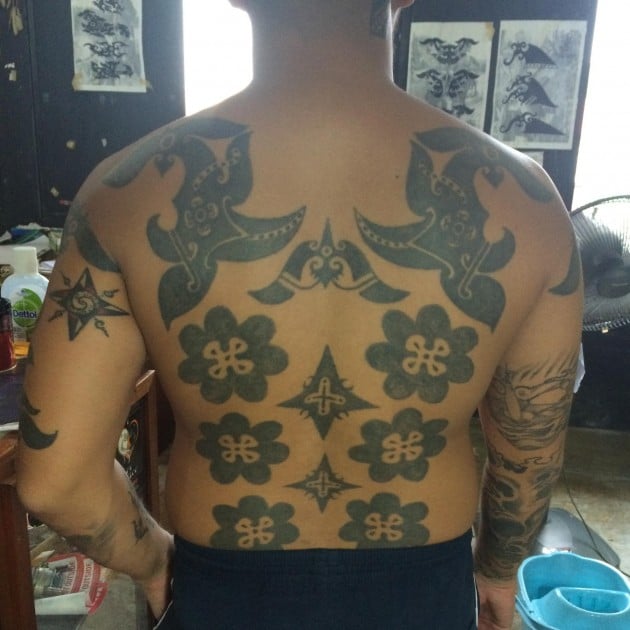 Most native tattoo motifs and designs are grounded in nature so for those who appreciate the art and would like lasting memento of their visit here, there are certainly a number of tattoo parlors in all major towns and cities able to do traditional pieces. And if you’d like to go the extra mile with yours, do look up the traditional art of hand-tapping tattoos a method that has become increasingly rare among artists due to the level of skill required although not impossible to find.
Most native tattoo motifs and designs are grounded in nature so for those who appreciate the art and would like lasting memento of their visit here, there are certainly a number of tattoo parlors in all major towns and cities able to do traditional pieces. And if you’d like to go the extra mile with yours, do look up the traditional art of hand-tapping tattoos a method that has become increasingly rare among artists due to the level of skill required although not impossible to find.
Getting here: If you happen to be in Kuching, there are quite a number of tattoo artists available in the heart of town, along Main bazaar, Wayang street and Carpenter street and if you’re unsure, you can always ask around for recommendations.
49. Have one of Sarawak’s signature drinks
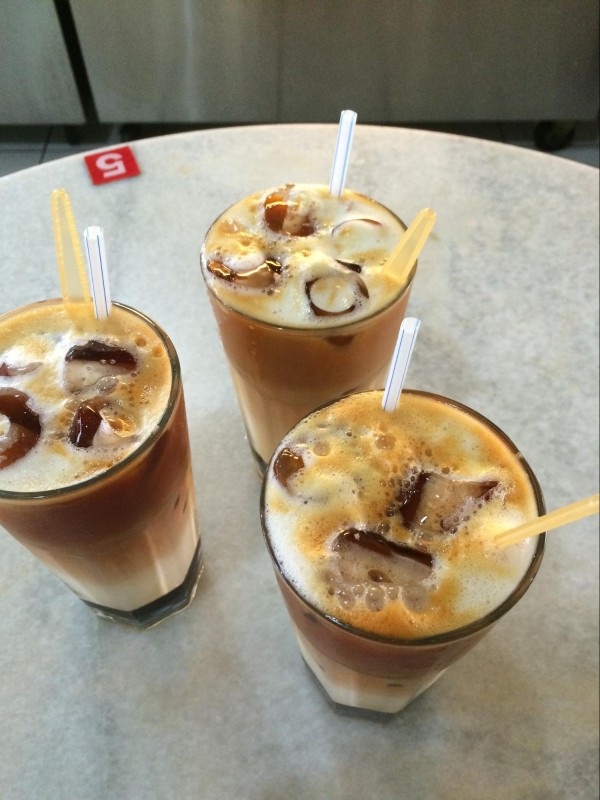 Home of the Teh-C-Peng, the Matterhon, the White Lady and the ABC special, Sarawak is known for a few famous (if oddly named) drinks. A classic breakfast favorite, Teh-C-Peng is a 3-layered drink of palm sugar, milk and brown tea. If you want something even fancier, you can get 5-layer tea which has an additional two layers of wheatgrass and cincau (herbal jelly).
Home of the Teh-C-Peng, the Matterhon, the White Lady and the ABC special, Sarawak is known for a few famous (if oddly named) drinks. A classic breakfast favorite, Teh-C-Peng is a 3-layered drink of palm sugar, milk and brown tea. If you want something even fancier, you can get 5-layer tea which has an additional two layers of wheatgrass and cincau (herbal jelly).
The other three ‘drinks’ however, are normally served in bowls and are in many ways, our versions of West Malaysian cendol. The White lady for example is a mixture of evaporated milk and tinned fruit while the Matterhon is a lighter lemony mix of cincau and longan. The ABC special on the other hand is usually a mixture of cincau, cendol, red beans and sago pearls, served with shaved ice and drizzled with coconut milk. Order yourself a bowl on a hot day and before you know it, it’ll be empty!
Getting here: Every hawker has their own spin on drinks, but here are my Kuching favourites: Hui Sing Hawker Centre, Ah Meng – Stall 18. Sin Chong Choon hawker centre @ Green Heights for their Teh-C. Jubilee Ground hawker centre, the drinks uncle there has a flair for making drinks, you can order one of the classics above or you can order stuff like the ‘Justin Bieber’! And for Miri, I’d definitely recommend you drop by Sin Wan Delight Rojak and Cold Drinks Centre.
50. Go On A Bike Tour
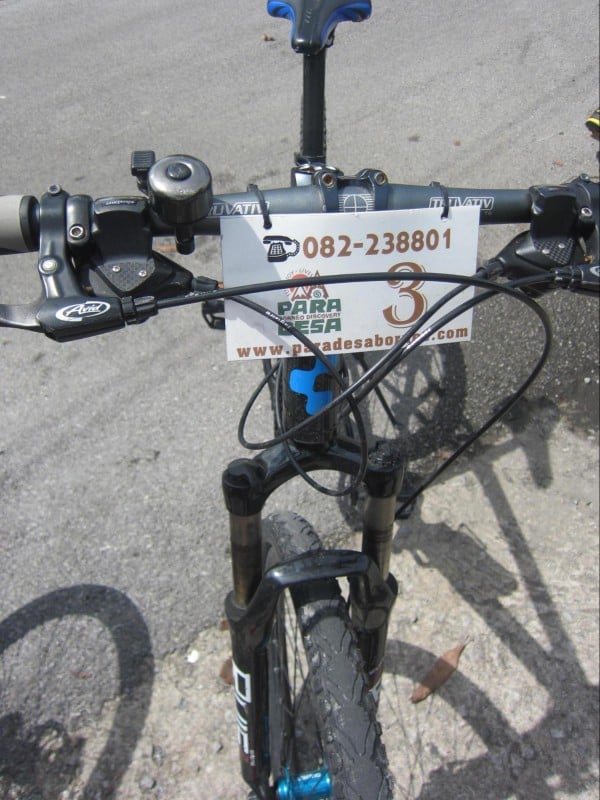 Bike tours are seriously one of the best ways to cover a lot of ground while still allowing you the opportunity to experience the most of what a place has to offer. At the time of writing, I only know of one company that operates bike tours and that’s Paradesa Borneo in Kuching, linked below.
Bike tours are seriously one of the best ways to cover a lot of ground while still allowing you the opportunity to experience the most of what a place has to offer. At the time of writing, I only know of one company that operates bike tours and that’s Paradesa Borneo in Kuching, linked below.
Paradesa Borneo offers some great packages for all skill levels, with rides ranging from proper mountain biking down in Bau to relaxed rides around town. One of Paradesa’s easiest tours, the kampong and open air market tour is not only a great introduction to local village life for foreigners but also allows city-dwelling Kuchingites to see different aspects of the city.
Learn from your guides about local beliefs and taboos, taste jungle fruit (and sago worms on the weekends) and be prepared to have a good time because Paradesa Borneo certainly know how to do a good tour!
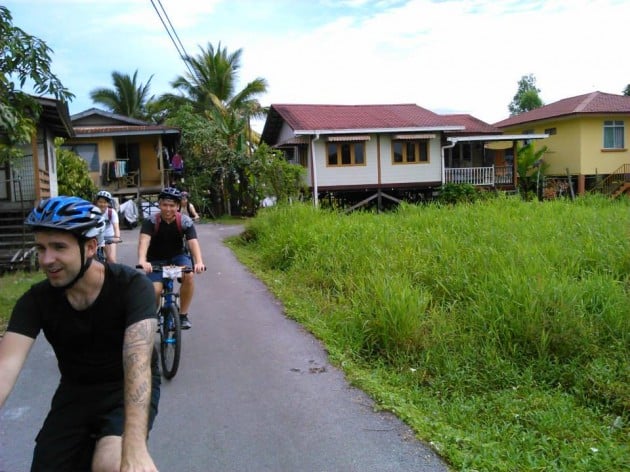 Getting here: Paradesa Borneo on Wayang Street (1, Leboh Wayang, 93000 Kuching Sarawak) although a quick search online will find you more packages such as on SpiceRoads that caters for longer journeys.
Getting here: Paradesa Borneo on Wayang Street (1, Leboh Wayang, 93000 Kuching Sarawak) although a quick search online will find you more packages such as on SpiceRoads that caters for longer journeys.
So Much To Do in Sarawak
With so many different ethnicities living under one roof, Sarawak is indeed a land rich in culture and tradition. And although we may be well-known for our mysterious rainforests and diverse wildlife, as a state, we’re so much more than just that!
So the next time you get the chance, drop by for a taste of adventure and tick off some of the items on this list while you’re at it because as you can see, there’s lots to see and do here in the land of the hornbill, for tourists and locals alike.
I can read minds. You’ll also love these articles!
|
|
|
|
|
|
